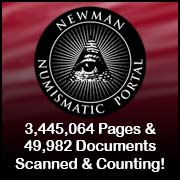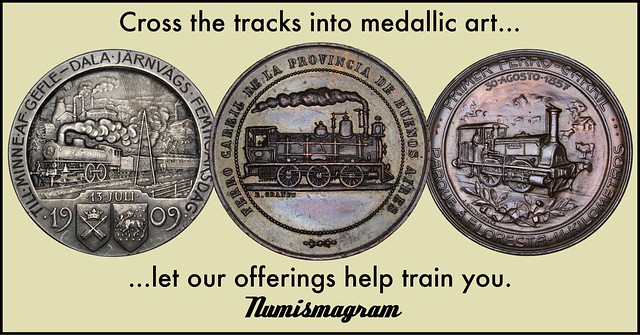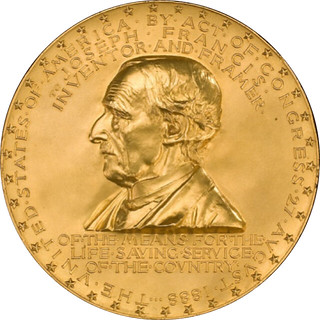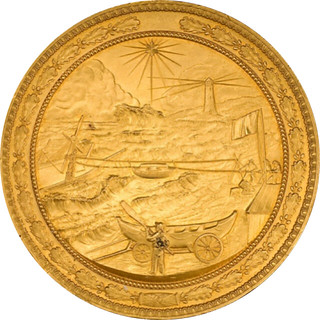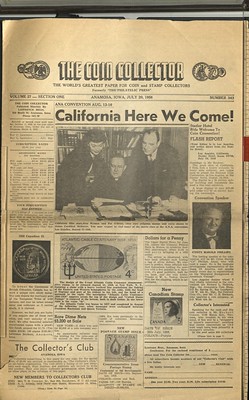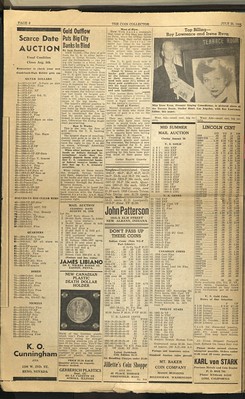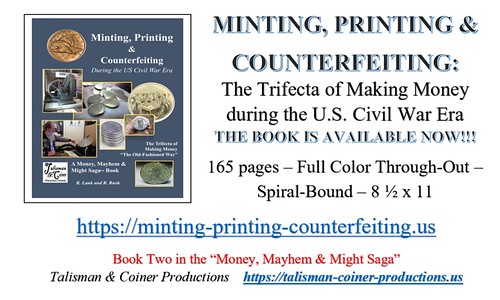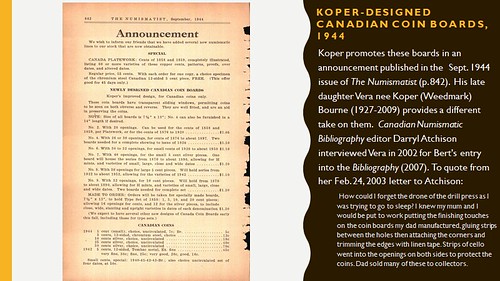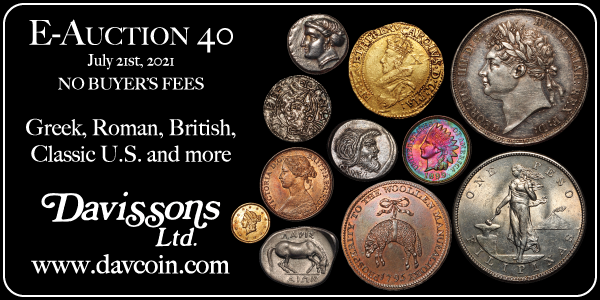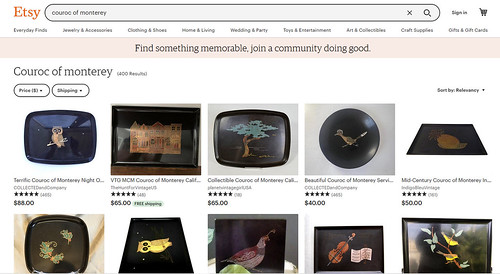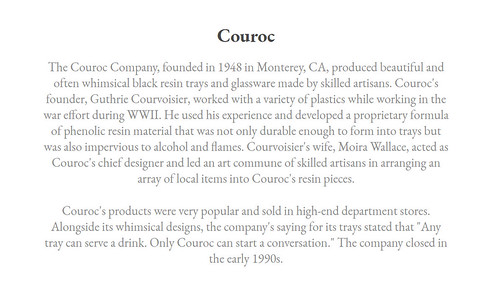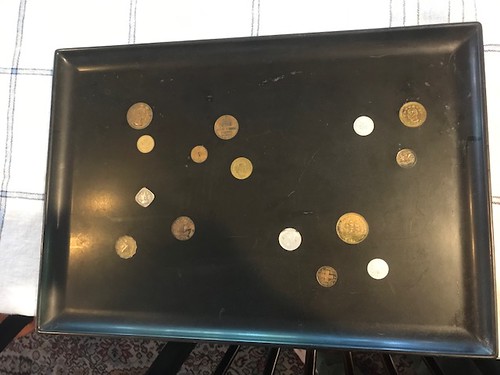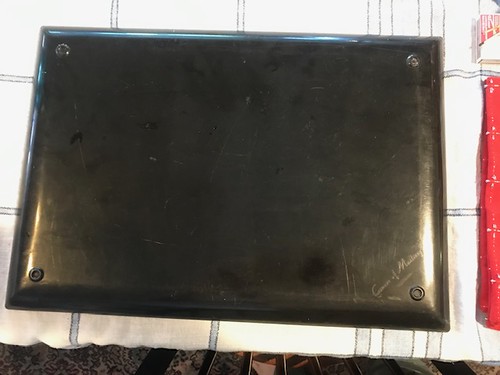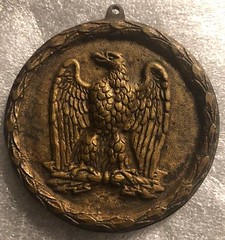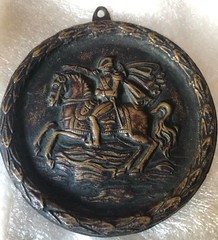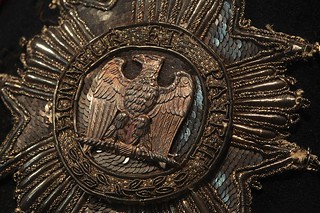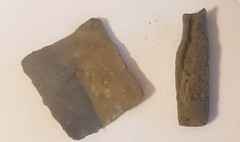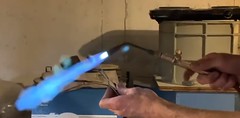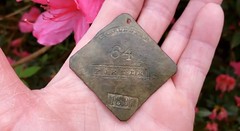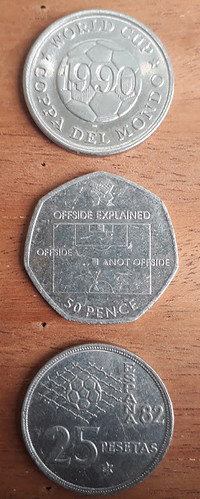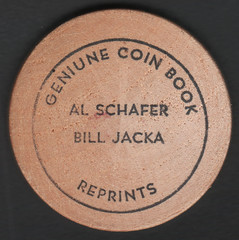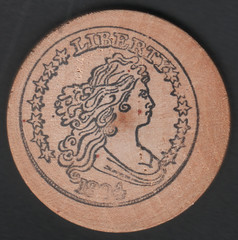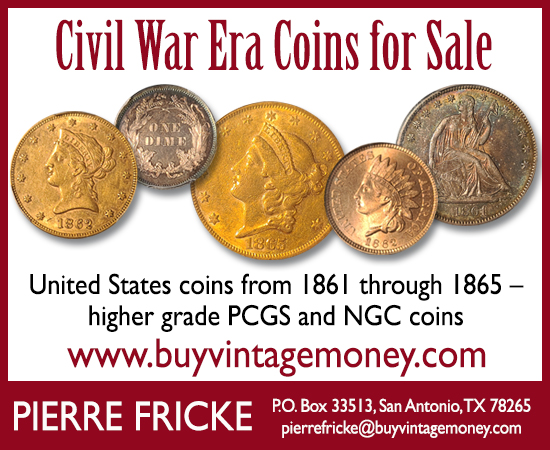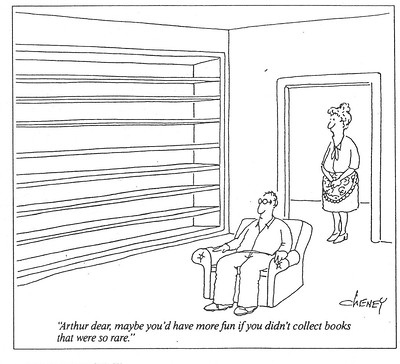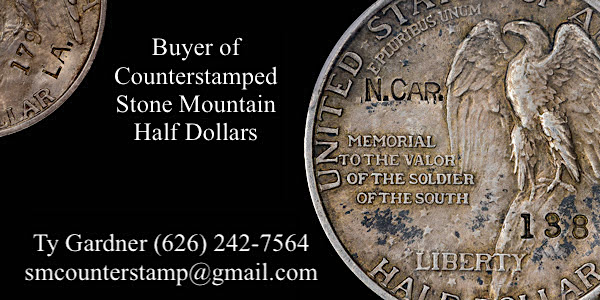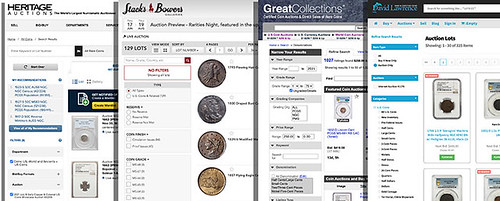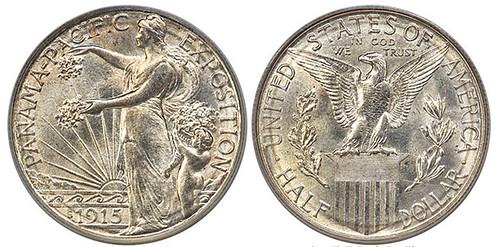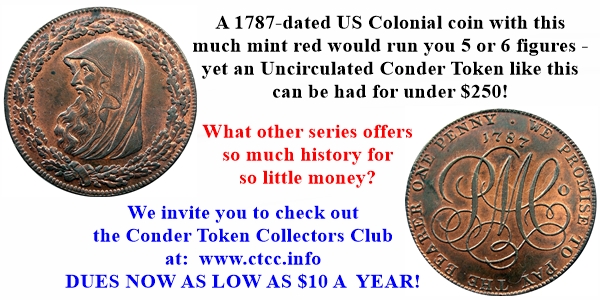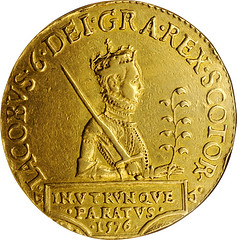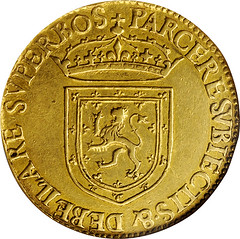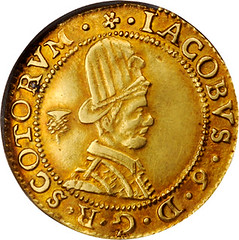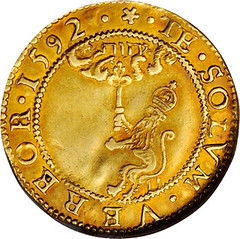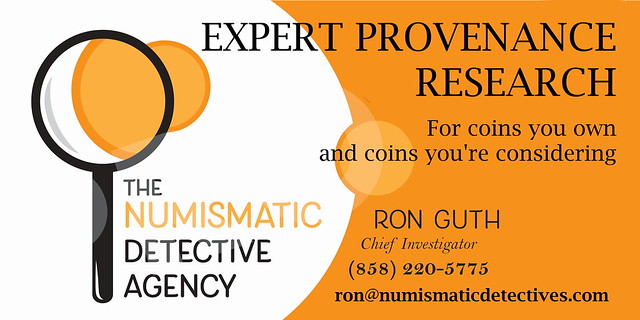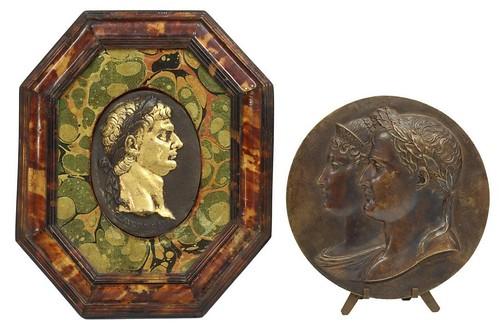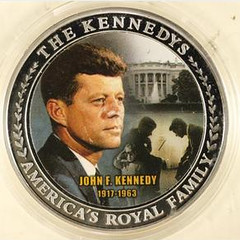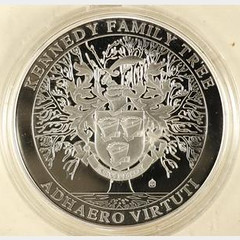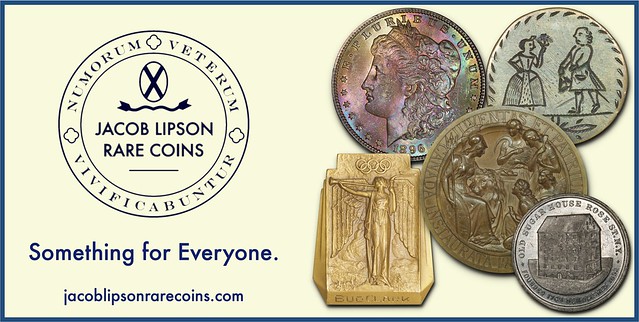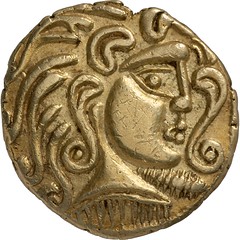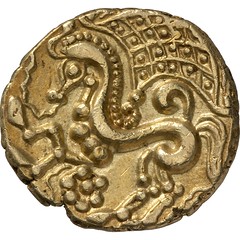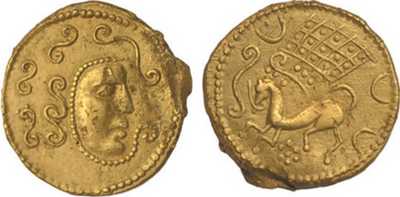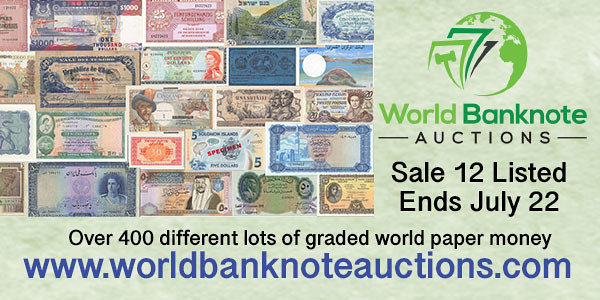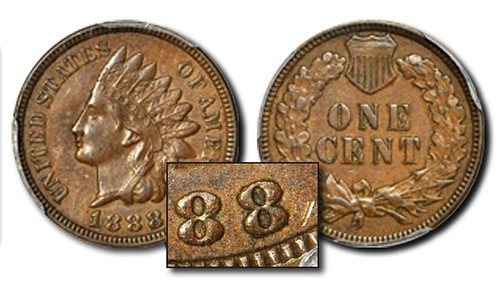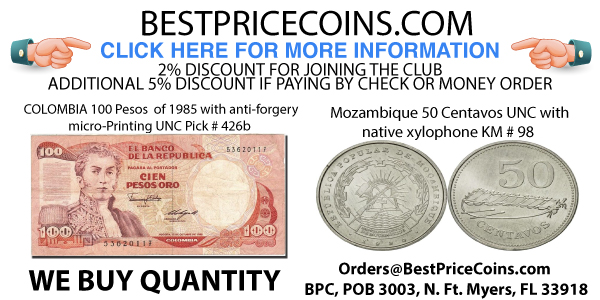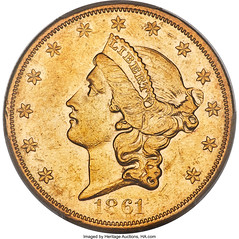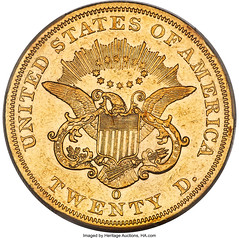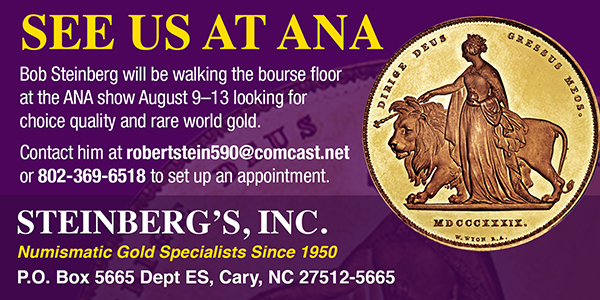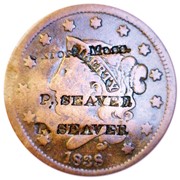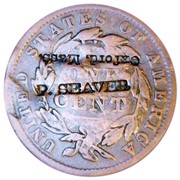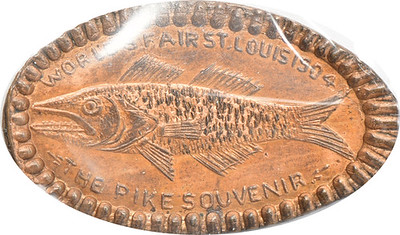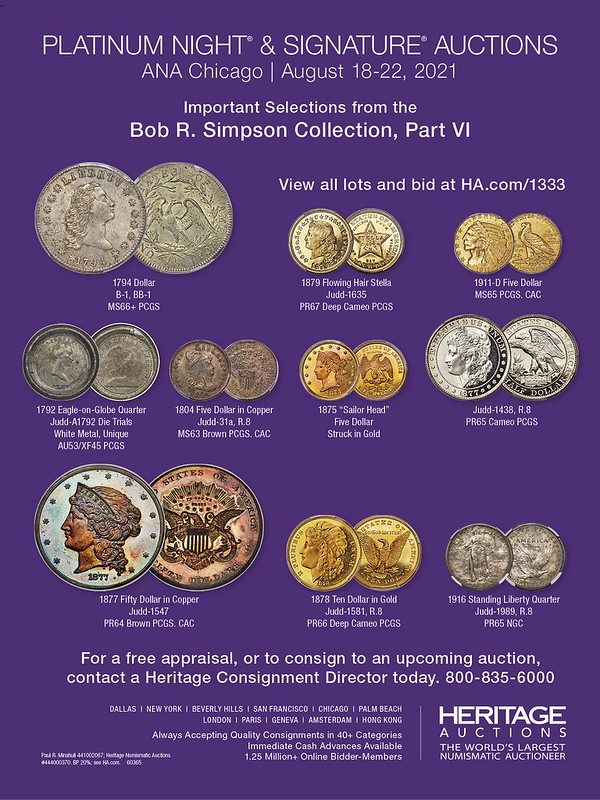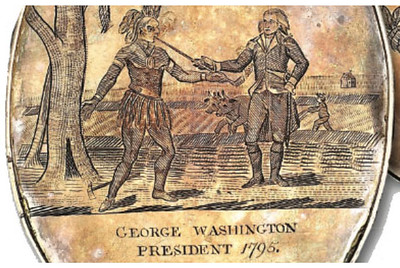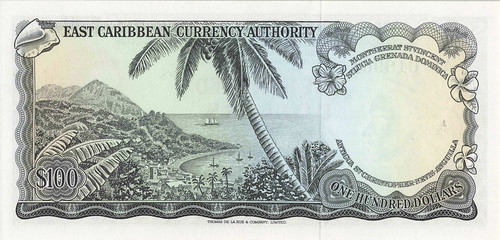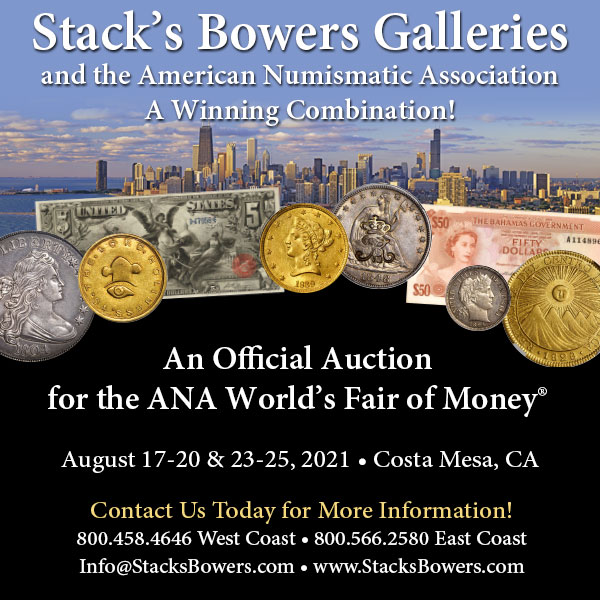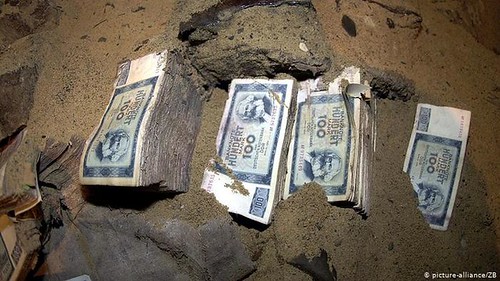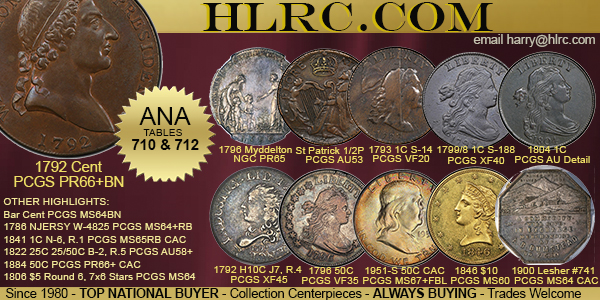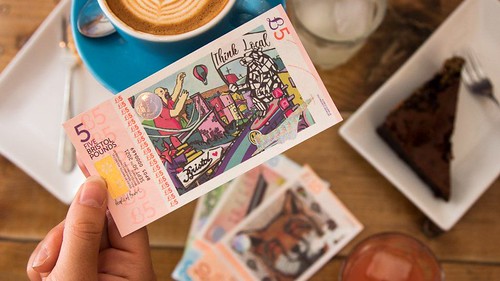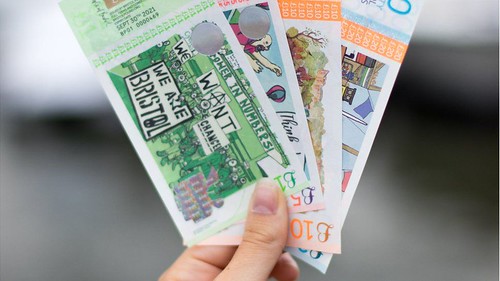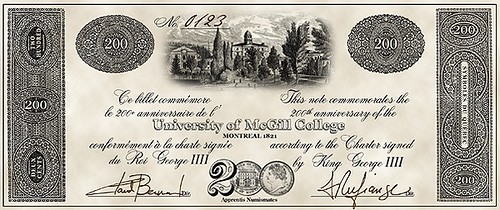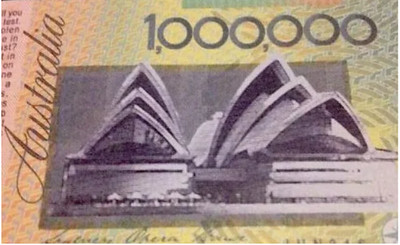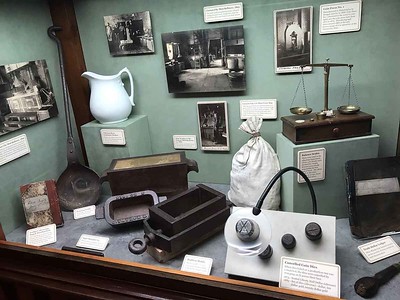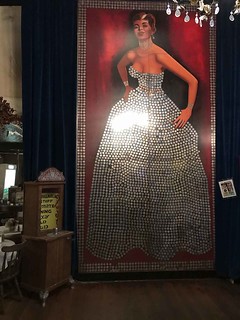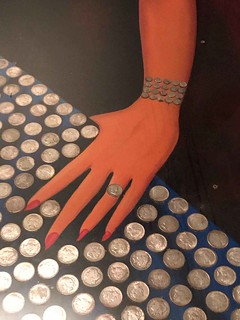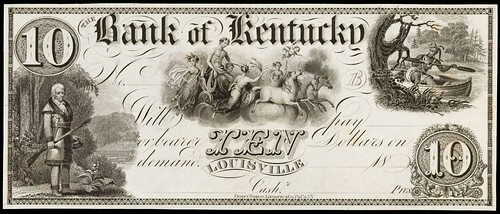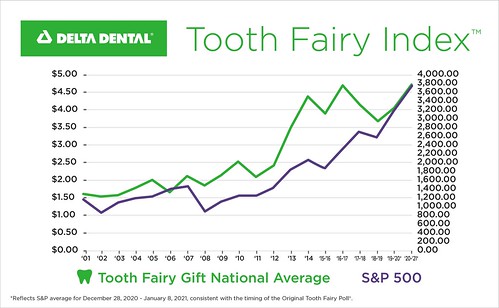
Visit our NBS Sponsors


About UsThe Numismatic Bibliomania Society is a non-profit association devoted to the study and enjoyment of numismatic literature. For more information please see our web site at coinbooks.org SubscriptionsThose wishing to become new E-Sylum subscribers (or wishing to Unsubscribe) can go to the following web page link MembershipThere is a membership application available on the web site Membership Application To join, print the application and return it with your check to the address printed on the application. Print/Digital membership is $40 to addresses in the U.S., and $60 elsewhere. A digital-only membership is available for $25. For those without web access, write to: Charles Heck, Treasurer AsylumFor Asylum mailing address changes and other membership questions, contact Chuck at this email address: treasurer@coinbooks.org SubmissionsTo submit items for publication in The E-Sylum, write to the Editor at this address: whomren@gmail.com BUY THE BOOK BEFORE THE COINSale CalendarWatch here for updates! |
- WAYNE'S WORDS: THE E-SYLUM JULY 11, 2021
- NEW BOOK: AFRICA'S LAST COLONIAL CURRENCY
- RAYMOND H. "ROCKY" ROCKHOLT (1930-2021)
- THE JOSEPH FRANCIS CONGRESSIONAL GOLD MEDAL
- RESEARCHING THE COIN COLLECTOR
- BERT KOPER'S ROLE IN CANADIAN NUMISMATICS
- MORE ON COUROC COIN PRODUCTS
- NOTES FROM E-SYLUM READERS: JULY 11, 2021
- OXFORD NUMISMATIC SOCIETY FOOTBALL COINS
- GENUINE COIN BOOK REPRINTS
- NUMISMATICS AND THE FORTSAS LIBRARY SALE
- READING AUCTION CATALOGUE LISTINGS
- VOCABULARY TERM: EXERGUE
- CAPT. ANDREW CHRISTIAN ZABRISKIE (1853-1916)
- THE 1715 FLEET SOCIETY
- ANS LYCEUM PHOTOGRAPHY WORKSHOP
- STACK'S BOWERS OFFERS LOCH NESS COLLECTION
- NUMISMATIC NUGGETS: JULY 11, 2021
- ALMOST EMPERORS: CAESARS WHO DIDN'T MAKE IT
- COINS OF THE PARISII
- THE COINAGE OF KING STEPHEN
- DISCOVERING THE 1888/7 INDIAN HEAD CENT
- 1861-O DOUBLE EAGLE
- OPERATION GET COIN MOVING AGAIN
- P. SEAVER: AN ABOLITIONIST'S COUNTERSTAMP
- THE KING OF ELONGATED COINS
- PARTRICK COLLECTION INDIAN PEACE MEDALS
- EAST CARIBBEAN STATES $100 BANKNOTES
- THE END OF THE EAST GERMAN MARK
- BRISTOL POUND TO BE WITHDRAWN
- 2021 MCGILL COLLEGE NOVELTY NOTE
- AUSTRALIAN 'KELLY BUCKS' SCRIP
- LOOSE CHANGE: JULY 11, 2021
- DESIGNING A BITCOIN BANKNOTE
Click here to read the thin version on the web
Click here to subscribe
Click here to access the complete archive
To comment or submit articles, reply to whomren@gmail.com
Content presented in The E-Sylum is not necessarily researched or independently fact-checked, and views expressed do not necessarily represent those of the Numismatic Bibliomania Society.
WAYNE'S WORDS: THE E-SYLUM JULY 11, 2021
 New subscribers this week include:
Edgardo Martinez Cabral.
Welcome aboard! We now have 6,683 subscribers.
New subscribers this week include:
Edgardo Martinez Cabral.
Welcome aboard! We now have 6,683 subscribers.
Thank you for reading The E-Sylum. If you enjoy it, please send me the email addresses of friends you think may enjoy it as well and I'll send them a subscription. Contact me at whomren@gmail.com anytime regarding your subscription, or questions, comments or suggestions about our content.
This week we open with one new book, an obituary, an update from the Newman Numismatic Portal, Notes From E-Sylum Readers, and more.
Other topics this week include The Coin Collector, Canadian dealer Bert Koper, the Fortsas Library sale, reading auction catalog listings, the 1715 Fleet, coin photography, rare coins of Scotland, coins of the Parisii and King Stephen, an abolitionist's counterstamp, the Bristol Pound and bitcoin banknotes.
To learn more about Africa's Last Colonial Currency, the Joseph Francis Congressional Gold Medal, dealer K. O. Cunningham, Canadian Money Talks, Couroc coin products, unfolding coins, Medals Struck in Honor of Abraham Lincoln, the 1861-O Double Eagle, Operation Get Coin Moving Again, and the King of Elongated Coins, read on. Have a great week, everyone!
Wayne Homren
Editor, The E-Sylum
NEW BOOK: AFRICA'S LAST COLONIAL CURRENCY
This blog article from the London School of Economics reviews a new translation of a 2018 book in French on the CFA Franc, "Africa's Last Colonial Currency". CFA stands for Communauté financière d'Afrique (Financial Community of Africa). -Editor
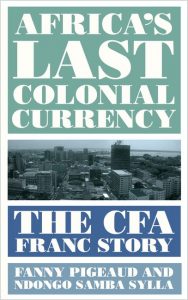 Africa's Last Colonial Currency: The CFA Franc Story. Fanny Pigeaud and Ndongo Samba Sylla (translated by Thomas Fazi). Pluto Press. 2020.
Africa's Last Colonial Currency: The CFA Franc Story. Fanny Pigeaud and Ndongo Samba Sylla (translated by Thomas Fazi). Pluto Press. 2020.
The central topic of Africa's Last Colonial Currency is how France exerts control over several African countries through the CFA system, ‘the oldest monetary union in the world'. With detailed discussions of the monetary mechanisms, Fanny Pigeaud and Ndongo Samba Sylla overwhelmingly demonstrate how this system, established in 1945, preserves a hierarchy wherein the benefits to France are ‘underestimated' and the benefits to African countries are ‘exaggerated'.
Much about monetary policy can be obscure, Pigeaud and Samba Sylla readily admit. Besides this, some of the central agencies have little motivation to simplify the matter for public debate. Indeed, the technical elements of monetary policy can be used to short-circuit discussions about the desirability of the CFA system. Still, the control of currencies can have enormous political-economic consequences because, depending on how this control is structured and exercised, it can be a cause of global inequality. This is certainly the case for the 162 million people living in the West African Economic and Monetary Union (comprising of Benin, Burkina Faso, Ivory Coast, Guinea-Bissau, Mali, Niger, Senegal and Togo), the Central African Economic and Monetary Community (comprising of Cameroon, Gabon, Chad, Equatorial Guinea, the Central African Republic and the Republic of the Congo) and the Comoros. These fifteen states comprise the franc zone, and they have France mediating their monetary policy.
This book has many audiences in mind including economic historians, postcolonial theorists and political scientists. It provides a political, diplomatic and technical history of the development of the CFA system, showing how currency arrangements are also conduits for wealth transfers from colonies to metropoles. It reviews how Africans struggled against this monetary system as well as the techniques the French state used to counter those attempts, like co-opting leaders and economic sabotage.
French monetary intervention in Africa has a long history. In 1825 King Charles X's regime minted coins for Goree, an island off Senegal and a site of the slave trade. Eventually the area of this currency was extended to counter British West African traders, often through military force to impose monetary transitions away from local indigenous currencies. In 1851, the French authorities established the Bank of Algeria, supervised by the Bank of France. Colonial banks like the Bank of Senegal were established in 1855 using funds derived from French state compensation paid to slave owners following abolition in 1848.
To read the complete article, see:
Book Review: Africa's Last Colonial Currency: The CFA Franc Story by Fanny Pigeaud and Ndongo Samba Sylla
(https://blogs.lse.ac.uk/lsereviewofbooks/2021/07/02/book-review-africas-last-colonial-currency-the-cfa-franc-story-by-fanny-pigeaud-and-ndongo-samba-sylla/)
RAYMOND H. "ROCKY" ROCKHOLT (1930-2021)
Pete Smith submitted these recollections of Rocky Rockholt. Thanks. -Editor
I learned of the death of Rocky Rockholt in the current issue of TEC News. Below is his listing from American Numismatic Biographies.
Rockholt, R(aymond) H(owell) "Rocky" Author
(b. 7/25/1930 d. 4/26/2021)
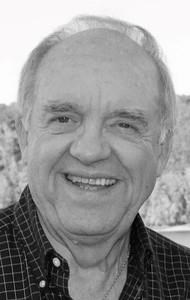 Born in Shawnee, Oklahoma. Attended Southern Methodist University in Dallas. Married Marilyn Beaver
June 29, 1951. They have two sons. Employed in marketing with Minnesota Mining and Manufacturing (3M) from
1956 until retirement in 1990.
Born in Shawnee, Oklahoma. Attended Southern Methodist University in Dallas. Married Marilyn Beaver
June 29, 1951. They have two sons. Employed in marketing with Minnesota Mining and Manufacturing (3M) from
1956 until retirement in 1990.
Rockholt began collecting in the early 1950's. He collected all series, cents through dollars, before deciding to specialize. He assembled an important collection of fractional currency buying collections from Matt Rothert, Dr. Kenneth Sartoris and George Wait. Highlights from this collection were sold at auction by NASCA September 12, 1981.
Rockholt contributed articles on paper money errors to Coin World and Numismatic News. He was a contributor to the books on paper money by William Donlon. Author of Minnesota Obsolete Notes and Scrip issued in 1973. It was published by the Society of Paper Money Collectors. Author of United States Department of Agriculture Food Stamp and Food Coupon Program 1939 to 199_.
Owner of the Penny Press Machine Co. LLC., from June 1990 to February 2017. He died in Burnsville, Minnesota.
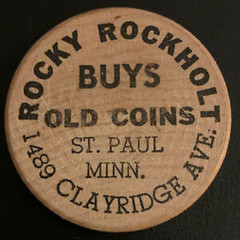 I interviewed him for the book on December 16, 1990. He provided elongated coins for our local coin show in 1995
and 1996.
I interviewed him for the book on December 16, 1990. He provided elongated coins for our local coin show in 1995
and 1996.
He and his wife had an interest in collecting antiques well beyond the field of numismatics. I saw them at a local antique show where they had a table selling Lalique crystal. He also wrote a book on Goebel figurines.
Rocky had a connection with one of the armed delivery services who receive bulk coins from the Mint and package them for delivery to local banks. He had a large quantity of common error coins like cents with clipped planchets. I realized that his supply well exceeded the demand from local collectors.
I last talked with him about five years ago. At the time he was still producing the kind of penny rolling machine found at tourist attractions. The company was sold in 2017. My club contacted him about providing a machine for our show in 2020 but that show never happened.
To read Rockholt's online obituary, see:
Raymond H. "Rocky" Rockholt 1930 - 2021
(https://www.legacy.com/us/obituaries/sanantonio/name/raymond-rockholt-obituary?pid=199329247)
THE JOSEPH FRANCIS CONGRESSIONAL GOLD MEDAL
Newman Numismatic Portal intern Garrett Ziss provided the following article based on recently added digital content relating to a great U.S. Mint medal. Thanks! -Editor
Even though he had been feted by many other countries, it wasn't until 1890 that the Congressional Gold Medal was bestowed upon 89-year-old Joseph Francis by President Benjamin Harrison. This American inventor dedicated his career to producing life-saving water craft, which was made possible by his invention of a machine that mass produced corrugated metal. His vessels were employed at coastal rescue stations around the world and saved thousands of lives.
The legislation authorizing the Francis Medal was passed on August 27, 1888, and the award was subsequently designed by Zeleima Bruff Jackson and modeled by Louis Saint-Gaudens. According to correspondence from the National Archives, the Mint was instructed to make the medal as large as possible and to execute it to the highest standards. This directive was certainly carried out, as the medal had an intrinsic value of $760…and required thirty-two blows of the press (each blow estimated at 300 tons) to obtain a perfect impression of the dies.
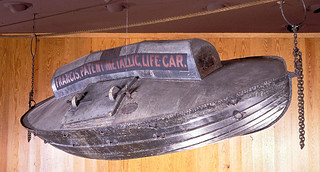 Although the Mint sent Francis five bronze copies of the medal at no cost, he requested several additional copies for which he was to be charged. When Superintendent of the Mint Oliver C. Bosbyshell quoted a price of $9 for each additional bronze medal, Mint Director Edward O. Leech deemed it to be too high. He encouraged Bosbyshell to reduce the cost and reminded him that
Although the Mint sent Francis five bronze copies of the medal at no cost, he requested several additional copies for which he was to be charged. When Superintendent of the Mint Oliver C. Bosbyshell quoted a price of $9 for each additional bronze medal, Mint Director Edward O. Leech deemed it to be too high. He encouraged Bosbyshell to reduce the cost and reminded him that We are not anxious to make a profit on this business of the manufacture of medals as we are to furnish copies to numismatic and other societies at as low a price as the cost to our service will justify.
Joseph Francis generously donated his Congressional Gold Medal and an example of his patented (1845) metallic life-car to the Smithsonian Institution and they reside in the National Museum of American History.
Newman Portal Project Coordinator Len Augsburger adds:
"32 blows from the press, wow! Even the ultra high relief Saints were only about a dozen."
Image: Joseph Francis Congressional Gold Medal (Image Courtesy of the Smithsonian Institution)
Image: Francis Patent Metallic Life-car (Image Courtesy of the Smithsonian Institution)
Link to ten letters regarding the Francis Medal:
https://archive.org/search.php?query=creator:%22U.S.%20Mint%22%20francis
Link to Francis Medal information in the 1890 Treasury Report:
https://nnp.wustl.edu/library/book/514742?page=240
RESEARCHING THE COIN COLLECTOR
Rusty Goe submitted this update on his research involving mail bid sales in The Coin Collector. Thanks! -Editor
After a little more than three weeks into my research project regarding K. O. Cunningham mail bid sales in The Coin Collector, I finally hit pay dirt. Not a big bonanza, mind you, but a sufficiently sizable vein.
With the helpful cooperation of Hang Nguyen, Ph.D., reference librarian at the State Historical Society of Iowa, I now have PDF copies of three of the five K. O. Cunningham sales for which I have searched.
Hang Nguyen followed the leads I sent and browsed through issues of The Coin Collector on microfilm at the Iowa library. Hang scanned the three K. O. Cunningham mail-bid advertisements found, including the cover pages for each issue, and emailed them to me.
Surprisingly, even though the microfilm roll in the Historical Society's library includes the issues of The Coin Collector that should display the two missing K. O. Cunningham mail bid sales, Hang could not find them. These are, as per Gengerke's listing (pg. 149, 2009 edition), issues dated March 20, 1957 (for a mail bid sale ending April 12, 1957), and February 20, 1958 (ending date March 10, 1958).
Akio Lis at the ANA library also assisted me in searching for the requested The Coin Collector issues. He found a hard copy of the same issue I have attached in this email (July 20, 1958). The ANA's library doesn't have any of the other four issues in question.
I also want to acknowledge Len Augsburger for sending (6/22/21) a tip about the State Historical Society of Iowa.
I had no idea what to expect to see in K. O. Cunningham's mail bid sales when I launched my search. He came to my attention many years ago while browsing old Reno, NV, newspapers. During the 1950s, dating to early 1954, he was apparently the go-to source for newspaper reporters in the area seeking information about CC
coins. From what I have discovered, he owned a desirable set of CC
Morgan silver dollars, as well as an impressive representation of CC
type coins. I don't think he owned any major rarities with the CC
mintmark. He did, however, lust after an 1876-CC twenty-cent piece. He told a reporter that if one surfaced it would cost around $2,500!
Cunningham's primary occupation was a dealer in a casino. One can only imagine the conversations about CC
coins (and collectible coins in general) that occurred among casino dealers in the 1950s who daily handled stacks of Morgan silver dollars.
In Cunningham's mail bid sale in the July 20, 1958, The Coin Collector, the 1871-CC Liberty Seated dollar in XF condition at the top of the list certainly stands out. Other than that, his sale is very sparse insofar as CC
coins are concerned. He lists only several CC
Morgan silver dollars, and that's it. At least these are the three rarest dates in this series.
This journey of discovery regarding K. O. Cunningham in The Coin Collector has proven rewarding. The rewards would increase further if I could find Prices Realized for Cunningham's mail bid sales. (That seems like a fool's errand!)
My file on Cunningham continues to expand. I enjoy learning about obscure figures with connections to Carson City coins, especially if they were considered experts in this field during their lifetimes—even if only within an isolated part of the country.
Thanks again for publishing my research requests to E-sylum readers.
Rusty adds:
"Of interest, other than the K. O. Cunningham connection, is a brief announcement of the sale of an 1894-S Barber dime for $3,200. This news apparently came from the New Netherlands Coin Co.'s auction in June 1958 (lot 581). The specimen sold is the so-called Ice Cream
dime, generally described as being in Good condition."
To read the earlier E-Sylum articles, see:
NOTES FROM E-SYLUM READERS: JUNE 20, 2021 : Query: The Coin Collector
(https://www.coinbooks.org/v24/esylum_v24n25a08.html)
MORE ON THE COIN COLLECTOR
(https://www.coinbooks.org/v24/esylum_v24n26a15.html)
BERT KOPER'S ROLE IN CANADIAN NUMISMATICS
On Wednesday, July 7 Howard Engel of Richard Stockley Books made an online presentation for the South Wellington Coin Society. Here's a synopsis. I was unable to attend, but David Gladfelter provided some commentary. Thanks. -Editor
Bert Koper (1899-1963), a Dutch immigrant to Winnipeg, almost single-handedly kept the torch of organized numismatics burning in Canada through the dark years of the Depression and World War II. His Park Coin Shop, Canadian Numismatic Art Society, and subsequent Canadian Coin Club Society (fl. 1935-1951) filled the gap between the Antiquarian and Numismatic Society of Montreal's demise in 1934 and the Canadian Numismatic Association's birth in Ottawa in 1950. Numismatic literature aficionados collect his publications; his enthusiasm inspires collectors today. He nearly succeeded in organizing a nation-wide numismatics association… Koper burned out, but he passed the Canadian numismatic torch to the R/CNA. He is Engel's local example of an unsung numismatist whose contribution to the hobby is worthy of research. You may find such numismatists in your own backyard…
David Gladfelter writes:
"Very informative. Engel credited Koper with having unsuccessfully attempted to form a national numismatic organization in Canada after la Société de numismatique de Montréal folded in the 1930s – longtime publisher of The Canadian Antiquarian and Numismatic Journal. Koper lived in Winnipeg and started the Canadian Numismatic Art Society in the 1940s which lasted a few years. Ironically, Koper was not involved in the formation of the Canadian Numismatic Association in 1950 (by a group of collectors in Ottawa) and never joined it nor contributed to its publications. He died in 1963. Engel made a case for belated recognition to Koper. He eventually plans to write up Koper's story."
Howard adds:
"One of my slides included a reference in The Numismatist, Sept. 1944, p. 842 of his own design and manufacture of Canadian coin boards, probably branded with the name of his business, the "Park Coin Shop" at 377 Henderson Highway, Winnipeg, Manitoba. I've never seen one of these, but apparently he made many of them, according to his daughter, Vera May (nee Koper) (Weedmark) Bourne (1927-2009). Here's the slide in question, in which I reproduce Koper's announcement of same from The Numismatist:"
Howard continues:
"I'd dearly love to find one, ideally to purchase to add to my collection or at least to obtain a scan to illustrate what one of these boards actually looks like to add to my "work-in-progress" presentation on Koper and his contribution to the development of numismatics in Canada.
"I had already asked coin board specialist David W. Lange back in 2016 and he was not familiar with them. When I got back to him in early 2020 to order his U.S. coin album books, he wrote "As far as the Koper holders, I've never seen or heard anything about them from anyone but you. They must be very rare in both countries."
 "I'd like to extend my request for any Koper material your readers may have and may be willing to part with, such as his Park Coin Guide from 1935 and 1936, periodical Money Talks (1938-1941) and Canadian Money Talks, (1948-1951) his undated error and variety studies on Canadian cents of 1858-1859 and the "Blackout" tombac 5-cent pieces from 1942, price guides, stock lists and memorabilia of his Canadian Numismatic Art Society (1937-1941) and the Canadian Coin Club Society (1947-1951) such as membership cards, participant ribbons to the national exhibitions held in Winnipeg in April 1938 and August 1939, correspondence and a photo of his shop."
"I'd like to extend my request for any Koper material your readers may have and may be willing to part with, such as his Park Coin Guide from 1935 and 1936, periodical Money Talks (1938-1941) and Canadian Money Talks, (1948-1951) his undated error and variety studies on Canadian cents of 1858-1859 and the "Blackout" tombac 5-cent pieces from 1942, price guides, stock lists and memorabilia of his Canadian Numismatic Art Society (1937-1941) and the Canadian Coin Club Society (1947-1951) such as membership cards, participant ribbons to the national exhibitions held in Winnipeg in April 1938 and August 1939, correspondence and a photo of his shop."
Great project! I'm unfamiliar with most of this material. Can readers help? Howard can be contacted at richardstockleybooks@mymts.net .
I do have some issues of Canadian Money Talks. Perhaps we'll scan them for the Newman Numismatic Portal. Above is the cover of Vol 1, No. 1 from October 1948. I have v1n1-4, v2n1-2-3 (four issues total). -Editor
MORE ON COUROC COIN PRODUCTS
Steve Shupe of Los Gatos, CA writes:
"Here is a little information on the Couroc company. I was given as a gift a tray made by this company with the Monterey Cyprus tree in the early nineties by my sister. Still a useful serving tray that we use when throwing a party.
"It is similar to Bakelite as a material. A screenshot of ETSY shows that they made many different designs and pieces and now sell used for about $50 with and without designs with coins."
Martin Kaplan writes:
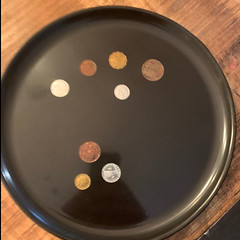 "We sold Couroc products in our retail store. As I remember they were popular in the 1970s-1980s? They offered
"We sold Couroc products in our retail store. As I remember they were popular in the 1970s-1980s? They offered standard
designs that were sold at wholesale trade shows and through their catalog. Serving pieces such as trays and bowls. A rectangular tray, about 12 x 18, was their signature product and based on my experience accounted for probably 75% or more of their sales. They were very accommodating in that they welcomed custom designs. The tray pictured last week is a custom design. You could send them some coins with a rough sketch and they would create a tray. As I remember the tray pictured retailed for about $25-$30,"
Ted Puls writes:
"My wife wanted send my inheritance to Good Will. My recollection is that my parents bought this in the mid 1960's. I admired it since the late 1960's due to my coin problem developing during this time. They didn't treat it very carefully as I recall so it may have been inexpensive. I send both obverse and reverse as would be appropriate for a coin related object. 45x32 cm, grading as a toned Vf. The company name is raised in the reverse. It has to be worth more than paper fragments of a comic."
Thanks, everyone. -Editor
To read the earlier E-Sylum article, see:
NOTES FROM E-SYLUM READERS: JULY 4, 2021 : Couroc Coin Plate
(https://www.coinbooks.org/v24/esylum_v24n27a12.html)
NOTES FROM E-SYLUM READERS: JULY 11, 2021
Philadelphia Mint Restriking Research ProjectDear Fellow Numismatists,
A current research project is to understand the restriking and distribution of circulation coins and pattern pieces by the Philadelphia Mint from about 1834 to 1897. Substantial progress has been made in identifying persons responsible and many of the coins involved; however, much remains to be discovered.
I would appreciate hearing from anyone with new or unpublished information, including private family papers, diaries and notebooks, that relate to this subject. While final analysis and publication of results remains in the future, the results are expected to wipe away many decades of speculation and innuendo.
Interested collectors may contact me at Seneca Mill Press LLC, P.O. Box 1423, Great Falls, VA 22066-1423.
Thank you!
Roger W. Burdette
In my introduction to last week's article about Irv Ratcliffe I referred to the National Association of Token Collectors as "NATCA". -Editor
Duane Feisel writes:
abbreviationNATCA. However, it didn't take long for the National Air Traffic Controllers Association to let me know that their organization had a copyright on NATCA – so I changed the abbreviation for the National Token Collectors Association to NTCA."
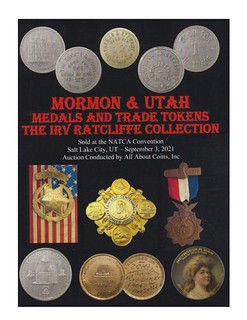
I had seen "NATCA" in the ad for the sale of Ratcliffe's collection, which I used as an illustration for the article (click to enlarge). So the original abbreviation lives on in some quarters.
When I created the Numismatic Bibliomania Society website back in 1997 I naturally thought of nbs.org as our domain name. Alas, it was already taken (and is still used by) the National Brotherhood of Skiers. We went instead with coinbooks.org, which is probably a better choice anyway. -Editor
To read the earlier E-Sylum article, see:
THE IRV RATCLIFFE MORMON AND UTAH COLLECTION
(https://www.coinbooks.org/v24/esylum_v24n27a21.html)
Coincidentally, Bill Groom writes:
"The National Token Collectors' Association is offering a free, two month trial membership. This allows access to their monthly journal, Talkin' Tokens. The July edition contains an article about a hoard of South Carolina tokens; this, in addition to a historical backstory that's connected to an abolitionist's counterstamp.
"Any collector who loves Americana will relish an NTCA membership! "
See Bill Groom's article elsewhere in this issue for a taste of the great content awaiting. Give it a try! Here's the club's website. -Editor
For more information, see:
http://tokencollectors.org/
http://tokencollectors.org/Admin/trial_membership_add.php
Greg Burns writes:
"Congratulations on the ANA literary award accolade! Very well deserved, and a treasured resource for the hobby in general and each reader individually…"
Thank you. Our intrepid webmaster Bruce Perdue has added the award to our E-Sylum home page. If you know people you think would enjoy The E-Sylum, send them to http://e-sylum.org/ . -Editor
To read the earlier E-Sylum article, see:
NBS EVENTS AT 2021 ANA WORLD'S FAIR OF MONEY
(https://www.coinbooks.org/v24/esylum_v24n27a02.html)
Last week Len Augsburger passed along a Newman Numismatic Portal user's query about the origins of this medal. -Editor
Pete Smith writes:
"I am sorry that I can't identify the mystery medal mentioned in the July 4 issue of The E-Sylum. I do have some observations. I think it is more appropriate to call it a medallion rather than a medal.
I wrote to Len Augsburger and he reported that the size is about 2 7/8 inch diameter. The piece has an integrated tab and hole indicating that it was intended for suspension. I suspect it is a jewelry piece. It might have been a generic award presented at a horse show.
There is no lettering on the piece. If it was intended to honor some person or event, it should identify that person or event. If it was an order or decoration, it should be identified.
I see no evidence that it can be considered Colonial.
The rider on the horse is wearing armor and a cape. He might be intended to represent a hero or knight but I see nothing specific for identification.
The eagle does not look like American iconography. The eagle is clutching a bundle of about six arrows pointing in both directions. The American eagle is typically shown with thirteen arrows and an olive branch. Also, the American eagle is typically shown with a shield.
The eagle looks more to me like a Roman eagle. Old iconography is often resurrected for more modern pieces and the Roman eagle does show up on some American items.
The workmanship is crude and more likely from cheap jewelry rather than a quality medallion. Without more identification, in my opinion, the value is minimal."
Chip Howell writes:
Interesting connection! Thanks. What do readers make of this? -Editor
Pete Smith adds:
"Yes, the Roman eagle evolved into the French Imperial Eagle and this might be the intended image on the medallion.
"I don't see Napoleon as the rider on the horse and the quality of the medallion is not up to what would be seen on a Legion of Honour medal."
For more information, see:
Legion of Honour
(https://en.wikipedia.org/wiki/Legion_of_Honour)
To read the earlier E-Sylum article, see:
NOTES FROM E-SYLUM READERS: JULY 4, 2021 : Identification of Colonial Medal?
(https://www.coinbooks.org/v24/esylum_v24n27a12.html)
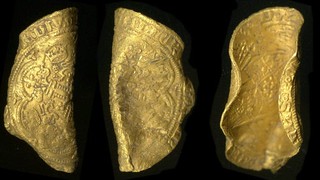 Alan Luedeking writes:
Alan Luedeking writes:
"In light of Carl Honore's excellent explanation, which makes perfect sense and opened my eyes to the mechanics of the thing, I have changed my mind and would now vote to leave the folded coins exactly as they are."
Ron Guth writes:
"Regarding unfolding coins, here's a pretty remarkable YouTube video of the unrolling of a slave tag."
To watch the video, see:
Finding 2 Slave Tags in 2 days? The Big Reveal!!
(https://www.youtube.com/watch?v=zFmgj6SAu1I)
Great find. Very interesting. Check it out. -Editor
To read the earlier E-Sylum articles, see:
NOTES FROM E-SYLUM READERS: JUNE 27, 2021 : Getting Bent and Unbent
(https://www.coinbooks.org/v24/esylum_v24n26a17.html)
NOTES FROM E-SYLUM READERS: JULY 4, 2021 : On Unfolding Coins
(https://www.coinbooks.org/v24/esylum_v24n27a12.html)
Ted Puls writes:
" I would like the recipe for electrolysis especially the electron delivering part. Being a cheapskate I didnt want to buy a car battery charger for experimenting."
To read the earlier E-Sylum article, see:
NOTES FROM E-SYLUM READERS: JULY 4, 2021 : Mudlark Cleans Coins With Electrolysis
(https://www.coinbooks.org/v24/esylum_v24n27a12.html)
Ted Puls adds:
"Finally I note that famous coin dealers who handle expensive coins are frequently mentioned but not the real hobby pillars. Captain Lee taught me and entertained me with coins throughout high school and college. I bet not one of your readers has heard of this unique rarity. He gave me a lifelong love of numismatics. How about Uncle Max, called VRUM by locals: very rich uncle Max
I doubt that he was rich after running a local diner all his life. He did offer to sell BU silver dollars to me for about 10 dollars because nobody was buying them before the Redfield hoard. Ken Hallenbeck educated me: coin dealers are entertainers
- without that, what good are they? Without the entertainment we hold only small bits of a commodity."
Quite true - you've got to be able to tell the story of a numismatic item. Just don't make it up and pass it off as the truth. -Editor
George Kolbe writes:
"K & F listed one in Auction 83 (Harry Bass 5), March 10, 2001:"
1028 (Sampson, H. G.). ADDENDA TO JUSTH COLLECTION OF COINS. (New York: Geo. A. Leavitt & Co., Auctioneers), April 8, 1884. Single sheet: 22 x 14 cm. Lots 201a-201u. A trifle browned but very fine. (50.00)
Not in Adams or Gengerke. Non-numismatic except for 201j: "1 $10 Gold Piece, empty [?]. Apparently rare.
Thanks. Dave Hirt was not the buyer - he's owned the catalog and accompanying addenda for many years. So at least one other example of the addenda exists somewhere. Who has it? Any of our readers? -Editor
To read the earlier E-Sylum article, see:
NOTES FROM E-SYLUM READERS: JULY 4, 2021 : Query: Emil Justh Sale Addenda
(https://www.coinbooks.org/v24/esylum_v24n27a12.html)
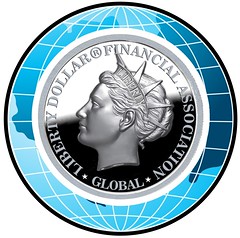 Scott Semans writes:
Scott Semans writes:
"Regarding Mr. VonHaus's latest hard money venture, neither the full article nor the website (as far as I can see) mentions whether monies invested are insured against confiscation. The article mentions "insured" and the website's FAQ page repeatedly assures that it is "legal" but what does that mean? There's nothing in the FAQs about insurance of any kind, nor does a site-search on "insure" return results. The last time I ordered silver "coins" - a decade or more ago - they were confiscated by the US government, and buyers who had prepaid got nothing. Caveat emptor!"
There are umpteen earlier articles in our archive; I've linked a few below. It's not the first time Von Nothaus has rebranded his operation. -Editor
To read the earlier E-Sylum article, see:
LIBERTY DOLLAR OFFICES RAIDED BY FBI
(https://www.coinbooks.org/esylum_v10n47a11.html)
LIBERTY DOLLAR FIRM REBRANDED AS LIBERTY NUMISMATICS
(https://www.coinbooks.org/esylum_v10n52a17.html)
THE LIBERTY DOLLAR IS BACK
(https://www.coinbooks.org/v24/esylum_v24n27a28.html)
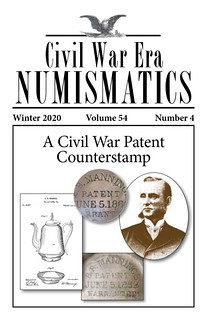 Bill Groom writes:
Bill Groom writes:
"Given a SNAFU by the USPS last December, the winter edition of the Civil War Token Society journal was published online. So, anyone can presently view it. Here's a link ....
http://www.cwtsociety.com/pdfs/
CWTS_Journal_Winter2020.pdf
"Coincidentally, this issue contains one of my counterstamp articles. Anyone interested in the Civil War should enjoy this typically members-only journal.
"Here's a link to the fine CWTS website ....
http://www.cwtsociety.com/"
Thanks! Have a look, everyone, and please do consider joining the Society. -Editor
Doug Nyholm writes:
"Have you ever heard of a company manufacturing custom unprinted book slipcovers? I have several books and multiple volume editions that I would like to be able to house in a slipcover. I have searched the internet to no avail and wondered if you have ever heard of a source for these."
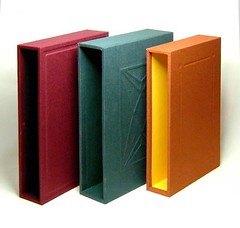
Many years ago I did have someone build a custom clamshell box for me, and I'm sure there are people making slipcovers, which are similar. I don't have any current contacts, but perhaps our E-Sylum readers can help. Does anyone have a recommendation for Doug? Thanks.
The more common term is "slipcase", and I was able to find sources using the search phrase "Custom Book Slipcase Maker". -Editor
OXFORD NUMISMATIC SOCIETY FOOTBALL COINS
"To celebrate England's success in getting to the final of Euros 2020 Oxford Numismatic Society has published a football post on its website."
To celebrate the England football team getting to the Euro Final here are a few football coins.
The middle one is an interesting design by Neil Wolfson, a sports journalist who chose an image which he felt would encapsulate the sport. it is one of the rarer commemorative 50 pence coins. I have previously suggested the Royal Mint brings out a penalty knock out coin. Let us hope there an England Winners 50 pence coin
Congratulations on the win! -Editor
To read the complete article, see:
Saturday, 10 July 2021
(http://oxfordnumismaticsociety.blogspot.com/)
GENUINE COIN BOOK REPRINTS
Dave Lange passed along this wooden nickel with a connection to numismatic literature. Thanks! -Editor
I'm not a collector of wooden nickels, but I had to buy this one as a research project.
I had never heard of Al Schafer or Bill Jacka, but I did find several mentions of both in The Numismatist archives. The March, 1962 issue reported that Michael Kolman, Jr. (a name I did know) was preparing a book on Ohio Civil War tokens and was being assisted in its preparation by Al Schafer of Cleveland. It was added that William Jacka of Bedford, Ohio was acting as an advisor. A board member of the Penn-Ohio Coin Clubs, Jacka was described as "one of the best known specialists in Civil War tokens in the United States." The January, 1965 issue reported that at a meeting of the North East Ohio Coin Club he gave a presentation on Indian wampum, "a subject on which he is one of the country's outstanding authorities."
Jacka was active in the hobby at least as far back as 1949, the time of his first mention in The Numismatist. During the 1954 ANA convention in Cleveland, he gave the invocation at the banquet. I didn't see Jacka or Schafer mentioned in Pete Smith's Numismatic Biographies at the NBS website, but Pete did have one prepared for Jacka. It's reproduced here with his permission:
Jacka, William M. Collector (b. 10/24/1891 d. 10/13/1972)
Born in Thorald, Canada. Served in the Army during World War I. Married with a daughter. Employed in the advertising business.
He had an extensive collection of Civil War Tokens including all coins illustrated in the 1924 Hetrich and Guttag reference.
Served as president of the Western Reserve Numismatic Club 1950-51. Exhibit chairman for the 1954 ANA convention in Cleveland.
obit: CW 12/6/1972
I wasn't able to find anything of substance regarding Schafer beyond his association with the Kolman book?, and evidently nor was Pete.
I don't know exactly what constitutes "genuine coin book reprints" as opposed to phony reprints, and I have no idea which titles the two reprinted. It's likely, however, that this activity occurred sometime during the 1960s, when many important books were out of print and little new research was being done to replace them.
Neat - I'd never seen one of these. You can add it to your 1804 Dollar collection, too.
Is anyone familiar with this publisher? What reprints did they publish? Does anyone have any of them? -Editor
NUMISMATICS AND THE FORTSAS LIBRARY SALE
Gary Oddie recently published an article for the British Numismatic Society blog relating to books and coins. Well worth reading - there is something here for both numismatists and bibliophiles, -Editor
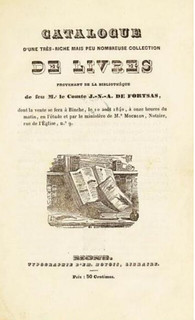 Few library sales catalogues have generated as much interest at the time or subsequently as that printed for the sale of the library of Mr le Comte J.-N.-A. de Fortsas on the 10 August 1840. The auction report appeared in a local newspaper, describing the strong bidding, along with some of the prices realised and names of the buyers. Original copies of the catalogue were selling at a significant premium shortly after the date of the sale and it has been reprinted and translated several times. Chapters of books have also been written describing the build-up to the sale, the day of the sale and its aftermath. The event even makes an appearance on a Wikipedia page. An original copy of the catalogue was auctioned recently by Sotheby's and made £3,250 against an estimate of £2,000-£3,000 and was subsequently seen offered for sale at £8,500.
Few library sales catalogues have generated as much interest at the time or subsequently as that printed for the sale of the library of Mr le Comte J.-N.-A. de Fortsas on the 10 August 1840. The auction report appeared in a local newspaper, describing the strong bidding, along with some of the prices realised and names of the buyers. Original copies of the catalogue were selling at a significant premium shortly after the date of the sale and it has been reprinted and translated several times. Chapters of books have also been written describing the build-up to the sale, the day of the sale and its aftermath. The event even makes an appearance on a Wikipedia page. An original copy of the catalogue was auctioned recently by Sotheby's and made £3,250 against an estimate of £2,000-£3,000 and was subsequently seen offered for sale at £8,500.
The following sections will present details of the sale and then three numismatic and bibliophilic connections that came to light whilst looking into this auction.
This was a very select library built by the late Comte de Fortsas, for which the only criterion for inclusion was that the book was the only known example. Rare and valuable books had been disposed of during the Comte's lifetime when he learned of another specimen. Thus, the numbering in the catalogue ranged from 3 to 222, but included just 52 books.
The auction was to take place at 11 o'clock on 10 August 1840, at the office of the notary Maître Moulon, 9 Rue de l'Église, Binche. Binche was a small town 10 km east of Mons and 60 km south of Brussels.
The catalogue was sent to booksellers, librarians, and collectors of rare books throughout Europe along with the message ‘Jean Nepomucene Auguste Pichauld, Comte de Fortsas', had been a collector of unique books — books of which only one copy was known to exist. ‘When he had died, on September 1, 1839, he had possessed 52 such books. His heirs, not interested in collecting books, had decided to auction the collection.'
A report of the auction was written up by M.L. Polain (keeper of the archives of the Province of Liége) and published on the evening of 10 August 1840 in La Politique of Liége.
Having worked through a facsimile copy and a few books and articles that describe the events surrounding the auction; as well as the obvious bibliophilic interest, there were a few hidden numismatic connections that have not been highlighted before. These will be described in the sections below.
Lot 23 in the catalogue appears as follows:
Which roughly translates: ‘Plate and description of the land and lordship of Rummen. Together the lineage and descendants of the lords of this land, by Dom. Cornelius Van Scheepdaal. Maastricht, Jean Nypels, 1615. A small 12mo, 88 pages, and two plates depicting the coins of Rummen, a very rare old binding in crimson satin with the arms of Rummen embroidered in silk and gold.' Rummen is a municipality in the province of Brabant.
The auction report for this lot went as follows: ‘No. 23 – M. Serrure, who occupies himself with numismatic researches concerning the Lords of Rummen, did not fail to come to purchase this work. He had for a competitor M. Chalon, his rival in this kind of serious and conscientious studies. The book was briskly disputed, and the 88 pages in 12mo were finally knocked down to M. Serrure at the enormous sum of 825 francs.'
At the time, a silver Franc was the equivalent of about an English silver shilling, so lot 23 sold for about £41 5s.
The winner of lot 23 is likely Constant Philippe Serrure (1805-72), the son of a diamond merchant from Antwerp. He was a professor at the university of Ghent and one of the outstanding Belgian scholars of the century. He had perhaps the best private coin collection in Belgium. He was prolific in many areas and a pioneer of numismatic studies in Belgium and the Low Countries. He was the father of Constant-Antoine Serrure (1835-1898), who wrote about the Cuerdale hoard in Les Monnaies de Canute et de Sifroid, rois pirates normands et fondateurs de comité de guines (928-965), Paris 1858. His collection of ancient and Continental monnaies, medailes, jetons, et livres numismatiques, were sold in 22 sales, 1869-1877, by the obscure notary / auction house of Ed. Macau, Tournai. The grandson of C.P. Serrure was Raymond Serrure (1862-1899), member of the RNS 1891-1899, who was a coin dealer based in Paris.
Please do read the complete article online - as Gary notes, "all is not as it initially appears." Meanwhile, enjoy one of my favorite cartoons about rare book collecting. -Editor
To read the complete article, see:
Numismatics and the Fortsas Library Sale of 1840 – Gary Oddie
(https://britnumsoc.blog/2021/07/06/numismatics-and-the-fortsas-library-sale-of-1840-gary-oddie/)
Numismatics and the Fortsas Library Sale of 1840
(https://britnumsoc.files.wordpress.com/2021/07/181-fortsas-oddie-001.pdf)
READING AUCTION CATALOGUE LISTINGS
Charles Morgan and Chris Bulfinch recently published an article on CoinWeek about an essential skill for collectors - reading auction catalog listings. Here's an excerpt - see the complete article online. -Editor
As a collector advances in the hobby, they might find themself nose deep in one of the many beautiful catalogs produced by the hobby's premier auction houses. These catalogs offer a unique blend of numismatic research, commentary, jargon, and marketing hype – all of which work to represent the interests of the consignor and help the catalog publisher instill excitement so that a given coin sells for the most money possible.
When it comes to the kinds of unique research that are published in auction catalogs, it is important to note that catalog writers often work in concert with the consignor, especially in the case of advanced and specialized collections, to present the backstory of the coin so that potential buyers will appreciate the richness and historic nature of an important or noteworthy piece. This collaboration is why the numismatic hobby has a fine tradition of researching provenance, studying the minute facets of a coin's appearance, and comparing one piece against all others known.
But there are other facets of a lot description that are important to understand, as well. Not every coin is a winner, but it is the role of the auctioneer to find a buyer for the coin regardless. And not every collector can afford to buy coins in optimal conditions and with illustrious pedigrees (or rare die varieties, for that matter). In the balance is a need to sell while conveying accurate information in the best possible light, and do so in such a way that the process can be replicated throughout thousands of lot descriptions published on a regular basis over the course of many years.
To this end, catalogers usually have advantages that collectors don't. Many if not most catalogers write with the coins in hand. They also have most of the germane and up-to-date reference works at hand, as well as many of the more obscure ones. Catalogers tend to have well-developed pattern recognition skills, long memories for certain coins, and a team of peers with which to bounce off ideas and double-check their work.
Some catalogers are also among the finest numismatic writers and researchers in the field. Indeed, the Numismatic Literary Guild awards prizes for auction catalogs, underscoring the importance and value of auction catalogs as numismatic literature.
Reading itself is easy for anyone with a basic education, but what the authors are writing about here is reading with a critical eye - understanding the nature of catalog writing, the personalities and motivations of those involved, and the larger context; the ability to "read between the lines" when relevant. -Editor
Learning to read auction catalogs is a critical skill for collectors. Being able to properly read a lot listing and interpret what is being said and extrapolate what isn't being said can provide a useful advantage when you are trying to narrow down which specific example of a coin that they might want to add to your collection.
Not every lot description is created equally, as you will see when we break down the three listings from three different auctioneers featured below. But every word of every description has a meaning that can be analyzed.
An astute reader has the makings of a successful buyer. Nevertheless, not every word you read should be taken at face value.
To read the complete article, see:
Reading Auction Catalogue Listings – An Essential Skill for Collectors
(https://coinweek.com/coins/coin-collecting-strategies-2/tips-for-new-collectors/reading-auction-catalogue-listings-an-essential-skill-for-collectors/)
VOCABULARY TERM: EXERGUE
Here's another entry from Dick Johnson's Encyclopedia of Coin and Medal Terminology. -Editor
Exergue. The segment of a coin or medal design beneath a base line, usually containing lettering. While exergue means the area beneath the base line, by extension it also means the lettering within this area. Designing any scene or illustration with a ground line and placing this in a circular shape gives rise to the area so described. From almost the beginning of the Renaissance medal, the exergue was being used. It was a logical place to put additional information: signatures, dates, mottos, inscriptions and such, some lines in smaller letters than others for variety. Only in rare instances was any ornamentation placed there, so important was it for lettering. An exergue can only exist on a circular or rounded bottom; if the area has square corners the lower portion is a plinth. See panel.
History of exergue. The earliest art medals of the Renaissance exhibit exergues. The dual portrait medal of Rene d' Anjou and Jeanne de Laval (Kress 24), dated 1463, contains an exergue on the reverse containing the artist's name: franciscvs lavrana / fecit in two lines beneath the base line of Peace standing next to an olive tree. The use of an exergue continued in medallic art from that time forwards.
The first coin designed with an exergue may have been a coin of Charles II, a halfpenny of 1673. The design of the seated Britannia obviously had a base line, but this was extended across the full flan on this coin with the 1673 date below in the exergue. The first use of the term, at least in English, was shortly thereafter, in 1697. It is widely used in numismatic cataloging.
A supraexergue is a similar area at the top of a design – as on a circular or oval medal – with a line across the top of the device creating an area above for lettering or symbols. The reverse of the United States oval Indian Peace medal series has such a supraexergue.
A bowed exergue was created for a Columbus medal of 1892; it showed the Landing of Columbus as a scene on the reverse and the design lends itself to a base that is an arc rather than a straight line. The lettering in the exergue is on a bowed base line congruent with the bowed truncation of the device.
A double exergue exists on a U.S. Mint medal, the Eleeazer Wheelock Ripley Medal of 1826, where a question of fact was raised to correct lettering already cut into this area (had Ripley indeed participated in the Battle of Erie, September 17, 1814?). When the correct information was furnished engraver Moritz Furst, he placed it on a higher plane than the rest of the exergue, creating the double exergue. [The author suspects he did this to save an already completed die without having to cut a new reverse die.]
To read the complete entry on the Newman Numismatic Portal, see:
Exergue
(https://nnp.wustl.edu/library/dictionarydetail/515870)
THE BOOK BAZARRE
CAPT. ANDREW CHRISTIAN ZABRISKIE (1853-1916)
Here's another entry from the online draft of John Lupia's book of numismatic biographies. Thanks! This is an excerpt with the full article and bibliography available online. This week's subject is author and collector Capt. Andrew Zabriskie. I added an image of Zabriskie's Lincoln medal monograph. -Editor
Zabriskie, Capt. Andrew Christian (1853-1916), 52 Beaver Street, New York.
He was born in New York City, New York on May 30, 1853, son of Christian A. (1829-) of New Jersey and Sarah Jane (Titus) Zabriskie (1833-), who were married in 1849 at New York City, New York, New York. He was born into one of the largest real estate owning families in that city. He studied at the School of Mines and Columbia College. After graduating from Columbia University, Zabriskie helped manage the family's real estate business.
In 1872 he is cited by his initials A. C. Z. in Mason's Coin and Stamp Collector's Magazine VI, No. 1, January (1872) : 20 ; and by the initials A. Z., in Mason's Numismatic Herald Vol. I, No. 1, June (1879) : 6a. Zabriskie was a lifelong collector. During his career he amassed a large collection, the most significant of which were Lincoln medals and Polish (i.e., coins and medals of Poland, not polished) coins and medals. His most lasting achievement as a collector is in the field of Political tokens and medals; most specifically his focus on the sixteenth president.
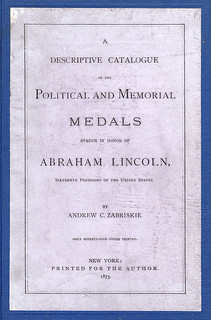 His pioneering work, "A Descriptive Catalogue of the Political and memorial Medals Struck in Honor of Abraham Lincoln", was published in 1873. Only seventy-five copies were printed, but it became the foundation of the collecting area which has become known as Lincolniana.
His pioneering work, "A Descriptive Catalogue of the Political and memorial Medals Struck in Honor of Abraham Lincoln", was published in 1873. Only seventy-five copies were printed, but it became the foundation of the collecting area which has become known as Lincolniana.
He was a member of the New York National Guard from 1873 through 1897, and eventually rose to the rank of Captain. Later in life he would be known as "Captain Zabriskie" due to this service.
A member of the ANS for forty-two years, Zabriskie first joined the ANS on December 1, 1874 and became a life member in 1894. The De Morgan Collection, papers written on this collection and that of the Censola Collection by Gaston L. Feuardent were read at the ANS Annual Meeting on March 19, 1878, by Mr. Zabriskie.
In 1880 he was a real estate dealer working for his family. In 1893 he donated 50 pamphlet cases to the ANS. On December 6, 1894 he exhibited at the ANS a Brasher doubloon. On June 6, 1895 he married Frances Hunter of New York working for his family's firm. During this same period he served initially as Third Vice-President from 1880-83 and then as First Vice-President from 1884-96 before finally being elected President of the ANS in 1896. He remained as President until his resignation in December 1904.
In 1902 he served on the ANS Committee on School for Coin and Medal Designing and Die Cutting. During the forty-fourth meeting on January 20, 1902 he gave his annual address and donated the gold O-ban of Japan the largest Japanese gold coin. In 1908, when the Society's constitution was amended to create the office of Honorary President, Zabriskie, along with Daniel Parish, Jr., was elected Honorary President for Life. His collection, which included superb large cents, was sold by H. Chapman on June 3-4, 1909.
Zabriskie's tenure as president of the ANS was marked with a financial crisis, which led him to advocate for the merger of the ANS with the New-York Historical Society. When that proposal was rejected by the membership of the ANS, he resigned from the presidency in December 1904. He was succeeded by Archer M. Huntington. He was also a member of the Holland Society.
Zabriskie died on September 16, 1916. His collection of 1429 lots sold through Henry Chapman, 10th sale. on June 3-4, 1909. Adams rating A
To read the complete article, see:
ZABRISKIE, ANDREW CHRISTIAN
(http://www.numismaticmall.com/numismaticmall-com/zabriskie-andrew-christian)
THE 1715 FLEET SOCIETY
Ben Costello submitted this information about the 1715 Fleet Society, dedicated to researching the history of the lost Spanish fleet and its treasure. Thanks! -Editor
The 1715 Fleet Society has a rather comprehensive website at 1715fleetsociety.com Please visit it sometime. We were founded in 2008 for the purpose of planning a commemoration of the 300th Anniversary of the loss of the Fleet. It actually did take 7 years to pull it off. We had a week long program which included receptions in 3 Florida communities that were long associated with wreck site remains ...Sebastian, Vero Beach and Ft. Pierce. The 11 ships that were destroyed in the great hurricane of July 30-31, 1715 were scattered over a 35 mile stretch of beach from Sebastian to Ft. Pierce, on the east coast. So, logically, that is where the focus of our commemoration centered. We also had a major exhibit in January, 2015, 7 months before the actual commemoration to kick off the year. This exhibit was in Orlando at the FUN Show. The exhibit was in conjunction with a partner ship we formed with the State of Florida. The State arranged to send their collection of Fleet coins and artifacts to Orlando for the exhibit.
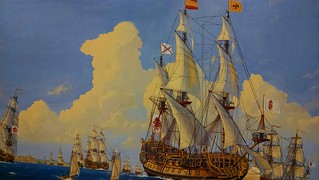 After the commemoration we changed our focus and became an educational organization engaged in research and the collection of documents regarding all things Fleet related, including numismatics. We scheduled a major conference on the 1715 Fleet during the commemoration. This took place in Vero Beach in July, 2015. The conference was such a success that we scheduled a second conference in 2017. This one was held at Flagler College in St. Augustine.
After the commemoration we changed our focus and became an educational organization engaged in research and the collection of documents regarding all things Fleet related, including numismatics. We scheduled a major conference on the 1715 Fleet during the commemoration. This took place in Vero Beach in July, 2015. The conference was such a success that we scheduled a second conference in 2017. This one was held at Flagler College in St. Augustine.
Following that success we scheduled a third conference which was to be held in Havana, Cuba in March, 2020. I actually went to Cuba in January to meet with my counterparts in Havana and to make sure that all of our arrangements were in order. Unfortunately, the pandemic forced us to cancel and reschedule the conference at a date to be determined after the Covid mess gets cleaned up. I am planning a conference in Key West next year to coincide with the 400th Anniversary of the loss of the Atocha.
The site has a nice bio of Ben. -Editor
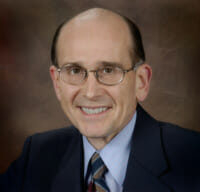 Ben Costello is one of the original three directors (which included Ernie Richards and Phil Flemming) who started the 1715 Fleet Society in 2008. He is an attorney from Washington, Pa. whose passion for shipwreck coins in general and the 1715 Fleet, in particular, began as an offshoot of his interest in numismatics which dates back to his early childhood. As a collector of early American U.S. coppers, he gravitated toward shipwreck coins because as he likes to say,
Ben Costello is one of the original three directors (which included Ernie Richards and Phil Flemming) who started the 1715 Fleet Society in 2008. He is an attorney from Washington, Pa. whose passion for shipwreck coins in general and the 1715 Fleet, in particular, began as an offshoot of his interest in numismatics which dates back to his early childhood. As a collector of early American U.S. coppers, he gravitated toward shipwreck coins because as he likes to say, These are coins that talk. They have a story to tell. Unlike most collectible coins, you can hold a shipwreck coin in your hand and know exactly where it came from. You know its history and its story. This is what intrigues me the most about these coins.
I feel a connection to its history
.
To read the complete article, see:
Ben Costello
(https://1715fleetsociety.com/ben-costello/)
ANS LYCEUM PHOTOGRAPHY WORKSHOP
The American Numismatic Society is sponsoring a workshop on numismatic photography. Here's the announcement. -Editor
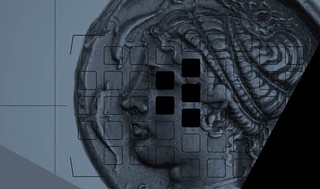 Registration for the third course of the ANS Lyceum is now open. Fill out the form below and submit tuition payment on the following page to register for the July 14 to August 4 ANS Lyceum "Photography Workshop". Sessions will be held on Wednesdays from 12:30 pm ET to 2 pm and will be taught by ANS Senior Photographer Alan Roche. Tuition for members of the American Numismatic Society is $100.00 USD. Tuition for this four-week workshop is $250.00 USD for non-members. The next page will confirm your registration and direct you to a payment page. Join the ANS today at
numismatics.org/membership/ to receive the membership rate.
Registration for the third course of the ANS Lyceum is now open. Fill out the form below and submit tuition payment on the following page to register for the July 14 to August 4 ANS Lyceum "Photography Workshop". Sessions will be held on Wednesdays from 12:30 pm ET to 2 pm and will be taught by ANS Senior Photographer Alan Roche. Tuition for members of the American Numismatic Society is $100.00 USD. Tuition for this four-week workshop is $250.00 USD for non-members. The next page will confirm your registration and direct you to a payment page. Join the ANS today at
numismatics.org/membership/ to receive the membership rate.
July 14—Basics of photography
July 21—Theories of coin photography
July 28—Digital post-processing
August 4—Class critique
The ANS Lyceum is an online educational offering of the American Numismatic Society. Over the course of several weeks, participants will have the opportunity to engage in interactive lectures and discussion sessions with ANS staff and curators. The ANS Lyceum is open to all with no prior knowledge of numismatics or history required or expected. See more information at http://numismatics.org/lyceum/.
Contact Austin Goodwin Andrews at aandrews@numismatics.org with questions.
STACK'S BOWERS OFFERS LOCH NESS COLLECTION
Stack's Bowers is offering a major collection of Scottish Coins. Here's the press release. -Editor
SCOTLAND. 20 Pound Piece, 1576. Second Coinage, Before Accession to English Throne. Edinburgh Mint. James VI (I of England). NGC VF-20.
Stack's Bowers Galleries is pleased to feature the Loch Ness Collection of Scottish Coins in their Official World Coin Auction for the ANA World's Fair of Money. It is a landmark cabinet that will stand as a reference of quality and rarity for generations to come. It provides a magnificent showcase across six centuries of coinage, spanning from the primitive sterling issues under David I in the 12th century to the final emissions of the Edinburgh Mint under Anne in the beginning of the 18th. This historic tour touches upon some of the most pivotal periods in Scotland and the British Isles, illustrating themes of the Middle Ages, the Renaissance, and the Enlightenment in dazzling gold and silver. Even the most recent of these coinages predate the American and French Revolutions by nearly a century.
This comprehensive offering of types and denominations includes over 100 coins and medals, ranging from the minuscule John Baliol halfpenny to the magnificent gold 20 pound piece of James VI, the largest gold issue of the British Isles. This 20 pound piece, with provenance to the Bridgewater House Collection begun in the 17 th century, plays the leading role amid an ensemble of historic treasures, many of which are world-class rarities in their own right.
SCOTLAND. Hat Piece (4 Pound Piece), 1592. Sixth Coinage, Before Accession to English Throne. Edinburgh Mint. James VI (I of England). NGC AU-50.
Other monumental offerings in the Loch Ness cabinet include an exceptional 1555 portrait ryal of Mary, a 1592 gold hat piece
of James VI, a gold double crown of Charles I, and a 1701 gold pistole of William II. Each of these pieces would, on their own, signify a world-class cabinet. In some cases, it has been decades since collectors have had an opportunity to acquire these types and it is very likely that it could be many more years before they are offered again.
The attention to quality and rarity places the Loch Ness Collection among the most accomplished cabinets of Scottish coins ever formed. It joins the ranks of such landmark collections as Murray, Lockett, Dundee, and LaRiviere, through which many of the present pieces can be traced. Not since the firm's 1976 offering of the Dundee Collection (in association with Spink), has Stack's Bowers Galleries presented such a masterful assemblage. The royal biographies from the Dundee catalog have been reprised, providing the crucial context behind these coinages and bridging the gap between these landmark offerings.
Stack's Bowers Galleries will present the Loch Ness Collection of Scottish Coins August 20, 2021, in their recently completed, state of the art Griffin Studios at the firm's Costa Mesa, California, headquarters. The Loch Ness Collection, along with their entire official ANA auction will be available for viewing and bidding at StacksBowers.com. For more information, call 800-458-4646 or email Info@StacksBowers.com.
NUMISMATIC NUGGETS: JULY 11, 2021
Here's a selection of interesting or unusual items I came across in the marketplace this week. Tell us what you think of some of these. -Editor
(lot of 2) Patinated bronze relief plaques, including: (1) French bronze patine medal, Emperor Napoleon Bonaparte and Marie-Louise in profile, signed in cast Andrieu fecit. (Jean-Bertrand Andrieu, French, 1761-1822), after a drawing by Dominique Vivant Denon (French, 1747-1825), on easel stand, medal: approx 4 7/8"diam, (1) framed bronze dore et patine medal, Claudius Caesar in profile, medal: approx 3.5"h, 2.75"w, overall: approx 7.5"h, 6"w; 1lbs total **Provenance: From a prominent Dallas, Texas estate** Start Price: $150.00
Unusual and nicely done. Great decoration for a numismatic office or library. -Editor
To read the complete lot description, see:
(2) BRONZE RELIEF PLAQUES NAPOLEON & CLAUDIUS
(https://www.liveauctioneers.com/item/107267915_2-bronze-relief-plaques-napoleon-and-claudius)
Political item collectors or curators assembling Presidential material may be interested in aftermarket lots like this one. -Editor
To read the complete lot description, see:
20 DONALD TRUMP TOKEN/COINS ALL DIFFERENT
(https://live.silvercityauctions.com/lots/view/4-319C97/20-donald-trump-tokencoins-all-different)
While we're on a Presidential theme, here's an item proclaiming the Kennedy family as "America's Royal Family". That reverse design is horrible, but the obverse colorization isn't bad. -Editor
To read the complete lot description, see:
1 1/2'' COLORIZED PROOF TOKEN KENNEDY FAMILY TREE
(https://auctions.bidalotcoinauction.com/lots/view/1-4SLKHS/1-12-colorized-proof-token-kennedy-family-tree)
ALMOST EMPERORS: CAESARS WHO DIDN'T MAKE IT
A CoinWeek article by Steve Benner discusses coinage of three "almost Emperors" who came close, but didn't ultimately ascend to be Emperor of Rome. This is an excerpt - see the complete article online. -Editor
This article deals with three men that, while seemingly destined to become the emperor of ancient Rome–indeed, they held the title of Caesar, or second-in-command–ultimately failed, for one reason or another, to ascend the throne.
Lucius Aelius Caesar (101-138)
The first person to fit into our category of almost emperor was a man named Lucius Ceionius Commodus, which was changed to Lucius Aelius Caesar after his adoption by the emperor Hadrian.
Figures 1, 2, and 3 show an aureus, a denarius, and a sestertius of Aelius. The aureus is very expensive since they were minted for only about a year and are rare. The denarius is priced high, but this is due to its excellent condition, however, a denarius of VF condition can be purchased at a reasonable cost. Like the denarius, the sestertius is expensive because of the EF condition, and, as a rule, this denomination can be somewhat costly in VF or higher condition. The quinarii are very rare, and the asses and dupondii are pretty much indistinguishable from each other and like the sestertius in pricing.
Figure 1: Aelius, as Caesar, 136-138 CE. AV Aureus. Rome mint. Struck under Hadrian, 137 CE. L AELIVS CAESAR, bare head left / TRIB POT COS II, CONCORD in exergue, Concordia seated left, feet on footstool, holding patera in extended right hand, leaning left arm on cornucopia set on seat. 18mm, 7.26 g., RIC II 443c (Hadrian). (Triton XIX, Lot 545, $15,000, 1/4/16).
To read the complete article, see:
Almost Emperors: Three Caesars Who Didn't Quite Make It and Their Coins
(https://coinweek.com/ancient-coins/almost-emperors-three-caesars-who-didnt-quite-make-it-and-their-coins/)
COINS OF THE PARISII
The Writer's Almanac for Thursday, July 8, 2021 mentioned the coins of the Parisii, the Celtic tribe that founded Paris. I've added some coin images. -Editor
It was on this day in 49 B.C. that the Parisii, a tribe of Celtic fishermen, first set foot in what would become the magnificent city of Paris. The Parisii settled on the banks of the Seine and formed a town that became known as Lutetia, which meant Midwater-Dwelling.
They mostly lived in thatched wooden huts, but they were smart, and fierce, and had their own coinage with their name on it, and began successfully trading with other European settlements. They built bridges, a fort, and minted coins. We mostly know about them from Julius Caesar's Commentaries on the Gallic Wars (52 B.C.), which detailed the sacking and pillaging of Lutetia by the Roman army in 52 B.C. Rather than give up their town, the Parisii burned it to the ground. The Romans won, though, and brought with them such modern conveniences as a theater, baths, a forum, and even a temple.
Remnants of the Parisii and the early town of Lutetia were first discovered in the 19th century when the medieval streets were torn up to accommodate Baron Haussmann's redesign of the city of Paris.
For more information, see:
Gaul, Parisii, Stater
(https://www.moneymuseum.com/en/coins?&id=75600)
The Celts from Northern Gaul - Third Generation Coins (c. 125 BC to c. 50 BC) - Coins of the Parisii
(https://collectingancientcoins.co.uk/the-celts-from-northern-gaul-third-generation-coins-c-125-bc-to-c-50-bc-coins-of-the-parisii/)
To read the complete article, see:
The Writer's Almanac for Thursday, July 8, 2021
(https://www.garrisonkeillor.com/radio/twa-the-writers-almanac-for-july-8-2021/)
THE COINAGE OF KING STEPHEN
A new online exhibit at the Hunterian museum in Glasgow highlights the coinage of King Stephen's reign. -Editor
Medieval English kings fiercely preserved their monopoly of the coinage. Coins were crucial to the economy, but also important symbols of royal power. If a monarch couldn't control the name and image that appeared on coins, what would that say about their authority, and those who usurped royal rights?
Control of the coinage famously broke down during the ‘Anarchy': a civil war between King Stephen (r. 1135-1154) and the Empress Matilda. Alongside Stephen's issues, Matilda also struck coins, as did individual barons, who may have been taking advantage of the absence of royal authority to build their own autonomous power blocs. Here too we find the first King of Scotland to mint coins, David I.
Coins can sometimes be ignored by historians, but their importance in how we understand the past is very clear from the ‘Anarchy'. Not only does coinage represent the breakdown of power and authority during this period, the variety of issues tell us a considerable amount about its history, how the spectrum of actors thought of themselves and crucially, how they wanted to be seen by others.
William Hunter's numismatic collection is one of his greatest legacies, with an important series of coins from the ‘Anarchy'. This is the first time that these rare coins have been on display together.
‘Anarchy' has been used to describe the reign of King Stephen of England since the 19th century. Between 1138 and 1154, the country was ravaged by a civil war in which contemporary chroniclers report the general population suffered terribly. According to the Anglo-Saxon Chronicle, so hopeless were people that they said that ‘Christ and his angels slept'.
Stephen issued seven ‘types' of pennies through his reign. Only two of them, types 1 and 7, issued at the beginning and end of his reign, before and after the civil war, were struck by moneyers working in towns across his realm. Henry II's early coins were also issued by mints across the country and were very similar to Stephen's. This illustrates the commitment to the restoration of royal authority after the civil war, and, together with coins of Henry I, the continuity of royal government.
Types 2 to 6 of Stephen's pennies were struck mostly in the south-east, the only region where his government retained control throughout the civil war. Elsewhere, other mints continued to issue type 1 pennies, which historians have often interpreted as representing residual local loyalty to Stephen and a commitment to maintaining the structures of his kingdom.
Non-standard coins of the king were also issued, possibly by moneyers suggesting how power was really working in the kingdom, or perhaps because Stephen and his government wanted to convey particular messages to the population.
To read the complete article, see:
'ANARCHY'? COINAGE OF KING STEPHEN'S REIGN
(https://www.gla.ac.uk/hunterian/visit/exhibitions/virtualdisplays/anarchy/)
DISCOVERING THE 1888/7 INDIAN HEAD CENT
Dave Bowers has a nice Stack's Bowers blog article about Jim Ruddy's discovery of the 1888/7 Indian Head Cent. Neat story. -Editor
In 1969 Jim Ruddy purchased a small cache of Indian Head cents found in an attic of a mansion in Virginia. These had never been examined by a numismatist. Jim had been interested in die varieties for a long time, and over a span of years had discovered several remarkable items, one of which was a new die for the 1786 Date Under Plow Beam New Jersey copper, a classic in that series.
Studying his newly acquired group of Indian Head cents by examining them under low-power magnification, Jim noticed that one bearing the date 1888 seemed to have traces of a 7 under the last digit. Could this be? No one had ever heard of such a thing!
Jim placed the coin under a microscope, and the small 7 became even more clear—and unequivocal. Although Indian Head cents had been a popular series for many years, no one had ever identified an 1888/7 overdate! He noticed that on the left obverse rim at the 9:00 position there was a cud
break, caused by a piece falling out of the die. Likely, this die had been retired quickly, accounting for the coin's rarity. Marvelously, his coin was in Mint State.
Lo and behold, a few coins later in the same collection, Jim came across another 1888/7, also in Mint State! Keeping his discovery secret, Jim looked at every other 1888 cent he could find, at shows and in several dealers' inventories. Not another piece came to light. The announcement of the discovery was made in early 1970, and Numismatic News, Coin World, The Numismatist, and other periodicals described this amazing addition to the Indian cent series.
Jim watched and waited to see whether other coins, perhaps thousands (as in the case of the 1938-D/S nickel), would be discovered. Few were. By 2006 only four Mint State 1888/7 were known, including the two that Jim discovered which originally went to collector Robert Marks and dealer Julian Leidman and, since then, have changed hands several times.
Today, experts estimate that 500 to 600 specimens exist mostly in the low grades of Good and VG with some in AU grades. In 2018 Stack's Bowers Galleries sold an AU-58 (PCGS) 1888/7 Indian cent at auction for $26,400.
In 1958 Dr. William H, Sheldon wrote in Penny Whimsy: Competent students in the field have always been hesitant to express an opinion on the rarity of a die because they were aware of how easy it is to be mistaken. No one can ever know for certain just how many examples of a particular variety exist, since there is no way of canvassing an entire supply of cents in one lifetime.
Seeing is believing, but it may not tell the whole story. If I attend a symphony and do not see Jones, he still might have been there. It is just that he did not catch my eye. If in my yard a visitor sees no wild deer, he cannot conclude that none are around, for the next morning I may see five of them nibbling on the grass. First, if a coin is actually seen, then it does exist. However, if it is not seen, it still might exist. Today, there are many valuable coins that exist but are not known to numismatists. Some of these will be discovered, to delight future generations.?
To read the complete article, see:
Jim Ruddy's Remarkable Find
(https://www.stacksbowers.com/News/Pages/Blogs.aspx?ArticleID=1888-over-7-inbdian-head-cent-rarity)
1861-O DOUBLE EAGLE
This Heritage press release discusses an interesting Civil War gold coin. -Editor
Civil War $20 Gold Piece Minted by New Orleans Under Siege
Most people may think of the US Mint as a fairly non-political institution, simply making coins for all people in America to use equally. However, mint buildings have been political pawns at a few points in history, especially during the Civil War. The 1861-O $20 gold pieces struck in New Orleans bear the dubious distinction of having been minted partially by Union forces, partly by the State of Louisiana, and partly by the Confederacy! One such historic and fascinating coin will be part of the upcoming July US Coin Auction #1332.
As our catalogers explain, the 1861-O double eagle is among the most historically significant issues in the series. Its production coincides with the outbreak of the Civil War, and, more specifically, the period in which the New Orleans Mint fell out of the control of the Union into that of the State of Louisiana, and later the Confederacy itself. Only one die variety has ever been confirmed to exist, so determining which coins were struck by which governing body has long been a subject of debate and speculation. The usually quoted division of the mintage is 5,000 pieces struck under federal control, 9,750 under the State of Louisiana, and 2,991 under the Confederacy. In Gold Coins of the New Orleans Mint, limited edition: updated 2020, Doug Winter presents a plausible hypothesis, based off of die states, for identifying coins struck by the Confederacy:
"After looking through hundreds of auction catalogs and studying images of 1861-O double eagles offered for sale, Joe Gaines and I have determined that around one-fifth of the coins offered had a strong date and showed the obverse crack. When one considers that the Confederacy is said to have struck approximately 17% of the original mintage of this issue (2,991 of the 17,741 struck) this is almost exactly the percentage of coins which exhibit the strong date and crack. We believe that these coins are the ones made by the Confederacy."
Under Winter's theory, the present Choice XF example would fall under those pieces likely struck by the Union or the State of Louisiana, since the date numerals are weak at the bottom and the radial die crack toward Liberty's chin from the dentils near star 2 is absent. The coin is certified by PCGS as XF45.
Similar coins have sold for around $30,000 and up in the past. Here is a link:
https://coins.ha.com/itm/liberty-double-eagles/1861-o-20-xf45-pcgs-variety-1/a/1332-3130.s
OPERATION GET COIN MOVING AGAIN
This article from Watertown, NY shows the continuing effects of the pandemic on coin circulation. -Editor
Local banks are seeing the effects of a coin shortage and are asking you to cash in those coins you have stored in a jar at home.
We're just right back at that full circle piece where we just want to get coin moving again, have our clients bring those in and just get it back into circulation,
said Janessa Sparacino, assistant vice president banking officer, Watertown Savings Bank.
When the COVID pandemic hit, fewer people were going out. And fewer people were using bills and coins out of fear of spreading the virus.
Meanwhile, the Federal Reserve has put a cap on how much coin it distributes, because still, one year later, it hasn't reached pre-pandemic levels.
The north country is already feeling the effect.
Last week was the first week that we really saw a substantial change in what we were able to receive,
said Sparacino.
Watertown Savings Bank has prepared for the shortage by stocking up on coin.
As for how long this will last, no one knows. That's why the bank wants you to contribute to Operation Get Coin Moving Again.
We'd be glad to take that coin off your hands,
said Sparacino.
A local laundromat added cashless payment systems. -Editor
It was a move the chain was set to make already, but the shortage and pandemic sped up that process.
After COVID, it just seemed like everybody went to debit and credit. They didn't want to touch money, for whatever reason. We put it on top of the list of things to do,
said O'Connell.
To read the complete article, see:
Coin shortage continues, banks ask you to bring in your spare change
(https://www.wwnytv.com/2021/07/07/coin-shortage-continues-banks-ask-you-bring-your-spare-change/)
P. SEAVER: AN ABOLITIONIST'S COUNTERSTAMP
Bill Groom submitted an article about an abolitionist's counterstamp. This is an excerpt - the full version appears in the July 2021 issue of Talkin' Tokens from the National Token Collectors Association (NTCA). -Editor
by Bill Groom
Few chapters in American history are as compelling and heart-wrenching as the one on slavery. Upon researching the below-pictured counterstamp, I was deeply reminded of that. An unknown maverick when acquired from a Dave Bowers box, it was unlisted by Brunk or Rulau. Since this P. SEAVER / Oxford, Mass. stamping was an uncommon surname and supplied a town/state name, I found it to be an irresistible purchase.
As anticipated, this counterstamp proved relatively easy to attribute. The only P. Seaver found in Oxford and lacking a middle initial was Perley Seaver; this, in the Worcester Almanac & Business Advertiser for 1850. He was therein listed as a machinist at Union Mill, home at 6 Arch. Machinists were among the most common trades to have made personal name punches. This was particularly the case if a patent was to be sought. According to the Encyclopedia of Massachusetts, biographical-genealogical (Volume 3), Perley Seaver, eldest son of Jonathan Seaver, was born in Monson, Massachusetts, in 1809, and there obtained a grammar school education (Ancestry records give alternate birth dates as March 4, 1801 or October 4, 1813!). Following schooling, he learned the trade of machinist and practiced that occupation for the remainder of his life.
William Titus Seaver, eldest son of Perley and Julia Maria (Field) Seaver, was born in Worcester, September 5, 1838. He spent his boyhood in Worcester and Oxford. Upon arriving at suitable age, he followed his father's example and learned the machinist trade in Springfield. It's quite likely that Perley's coin, dated to William's birth year, may have been passed along as a keepsake to his eldest son.
Perley invented adjustable calipers, recorded by the Franklin Institute in 1854. He was granted patent # 11,180 for his calipers on June 27, 1854. Pictured below is a pair of his calipers that sold on Etsy for over $2,000!
These calipers helped Perley gauge the measurements of wood products. His interest in precision workmanship is likely why Stephen Barton hired Perley as the superintendent for his North Carolina business venture ....
The article details Perley's travails as the manager of a saw mill, where he drew the ire of locals for allowing some slaves to attend his Bible readings and sermons. He was forced to leave and lost his property. -Editor
Unlisted by Brunk or Rulau, Perley's counterstamp is likely unique; this, as no other examples have surfaced in almost two decades now. Perley worked as a machinist, so he had no need for advertising. His precision calipers spoke well of his talent. Many a mason carried a calling-card coin like this. These pocket pieces proved conversation starters for owners to introduce themselves to fellow masons. They also served as badges of sorts, lifelong keepsakes; eventually, to pass along as family heirlooms.
The true value of Perley's coin resides in the genuine history it conveys. When seeking to unlock the mystery inherent in any given counterstamp, a history lesson often unfolds. While the detective work can be frustrating at times, the joy of discovering intriguing backstories, historically inherent to these artifacts, can be most educational. Few coins better illustrate this highly satisfying phenomenon as well as Perley's piece does.
Thanks. Great history. See "Notes From E-Sylum Readers" elsewhere in this issue for more information on NTCA and how to join. -Editor
For more information, see:
http://tokencollectors.org/
THE BOOK BAZARRE
THE KING OF ELONGATED COINS
Len Augsburger passed along this article about the upcoming sale of one of the world's earliest souvenir elongated cents, made at the 1904 World's Fair. Thanks. -Editor
Have you ever gone to the zoo or a museum and received a stretched coin as a souvenir? Well, the The King of Elongated Coins
from the 1904 World's Fair is up for auction and the lot including two other coins could be worth up to $4,000.
Over 100 years ago there were machines along the midway at the Louisiana Purchase Exposition in St. Louis making coins for keepsakes. The Pike Souvenir elongated cent was made from a 1904 Indian Head cent.
The midway is also known as The Pike.
So, the image of the Pike fish on the coin and the name of the coin are a play on words.
The coin is in excellent condition. The auction's description describes the cent as one of the finest graded by the Numismatic Guaranty Corporation:
"Obviously rolled and then put away into careful storage, the surfaces exhibit substantial mint orange — is that the proper way to describe color after a cent has been elongated? — and the Indian design itself remains plainly discernible on the reverse, itself still showing a lot of orange color."
You can see the coin on July 23 at Scotsman Coin & Jewelry's Midwest Summer Sale. It will be at the Saint Charles Convention Center in Saint Charles along with the Missouri Numismatic Society's convention. Online bidding is underway now.
To read the complete article, see:
‘King of Elongated Coins' up for auction from the 1904 World's Fair
(https://fox2now.com/news/king-of-elongated-coins-up-for-auction-from-the-1904-worlds-fair/)
PARTRICK COLLECTION INDIAN PEACE MEDALS
Greg Reynolds published a Greysheet blog article about the George Washington Indian Peace Medals sold in the recent Heritage Partrick sale. The article includes an interview with E-Sylum contributor Alan Weinberg. Here's an excerpt - see the complete article online for more. -Editor
Two American Indian Peace Medals from the 18th century were highlights of the special Partrick Platinum Night auction session on April 22. This was part of a large auction extravaganza conducted by Heritage at this firm's headquarters near the Dallas Fort Worth Airport.
The most noteworthy result in this Partrick session was the $630,000 paid for a 1793 Indian Peace Medal that depicts George Washington, the first president of the United States. He was earlier the commander-in-chief of American revolutionary forces during the battle for independence from Great Britain.
I had already decided to focus upon this Washington 1793 Indian Peace Medal before I contacted Alan Weinberg, a legendary collector of early American numismatic items. Parts of Alan's collection were auctioned by Heritage in multiple sessions during 2019 and 2020. Weinberg purchased most of his rarities long ago, during times when market levels were much lower than they have been during the last twenty years. I was surprised to learn that he was the buyer of this medal, for a record price.
Weinberg identified himself as the buyer and agreed to be interviewed. He furnished his own photos of this medal. He says he received this medal on Tuesday, April 27, soon after the Partrick session on Thursday, April 22. Alan was ecstatic.
To acquire a choice, well engraved, hallmarked by Joseph Richardson, oval George Washington Indian Peace Medal is almost literally a once in a lifetime opportunity. I was determined to acquire it as I'm 77 and will have no future chance,
Weinberg declared.
Alan begin collecting coins in 1958. I skipped the usual sets of coins and immediately progressed to 1793 Chain and Wreath large cents, buying a choice clean Very Fine 1793 Chain ‘with periods' cent for $675 in a 1962 Stack's auction. By 1962, I was acquiring significant choice colonial rarities from Dick Picker and Bill Anton for up to $3,750 [each]. In June 1962, the summer I graduated from high school, Dick Picker phoned to offer me the Virgil Brand Brasher doubloon for $14,000. A few weeks later he again called to offer me the Brand 1786 date under plowbeam New Jersey Copper for $8,000. Unfortunately, I passed on both ultra-rarities not having the money in hand. I should have asked my father if …,
Weinberg now reveals.
Weinberg collected a variety of 18th and 19th century medals, though this is his sole acquisition of a choice Washington administration Indian Peace Medal. These are distinct as they are silver ovals and were directly engraved. Later U.S. Indian Peace Medals were round and were struck from dies rather than being directly engraved.
The article includes a discussion of the known examples and some believed to be modern reproductions. Be sure to see the complete article for more. -Editor
Two similar Washington administration Indian Peace Medals were auctioned in the Partrick auction session in January. These realized substantially less than the presently discussed $630,000 medal that sold in April. This 1793 medal is not rarer as a date than the 1792 and 1795 medals that sold in the Partrick session in January. This 1793 is, however, technically more impressive. The technical rating of a coin or medal relates to hairlines, contact marks, consequences of cleanings or dippings, abrasions from handling, additives, etc.
Reportedly, Washington administration Indian Peace Medals dated 1789, 1792, 1793 and 1795 are known. There is a 1789 medal that is pictured in works by Bauman Belden and there was a 1789 in the Ford II sale by Stack's (NY) in May 2004 that was identified as a modern copy
by the cataloguer.
I am not convinced that a genuine 1789 medal exists, though I am not now prepared to draw a conclusion. Alan Weinberg is suspicious of the 1789 George Washington Indian Peace Medals that have come to his attention, which he believes are not authentic and were likely to have been made much later than 1789.
Bauman Belden's primary work on Indian Peace Medals was published by the ANS in 1927. This monograph is available on the Newman Numismatic Portal. The stories surrounding the two 1789 medals that Belden mentioned are vague and unconvincing. The 1789 that is pictured in Bauman's work is much different from and artistically inferior to widely accepted 1792, 1793 and 1795 medals.
To read the complete article, see:
Series Analysis: Thrilling Indian Peace Medals in Partrick Collection - The Panoramic Partrick Collection, Report #2
(https://www.greysheet.com/news/story/series-analysis-thrilling-indian-peace-medals-in-partrick-collection-the-panoramic-partrick-collection-report-2)
EAST CARIBBEAN STATES $100 BANKNOTES
The World Banknote Auctions Sale 12 ends July 22, 2021, and lots are open for bidding on the firm's website. Founder Dennis Hengeveld published an article about the East Caribbean States $100 Banknotes. Here's an excerpt. -Editor
East Caribbean States: An Introduction
Starting in the early 17th century, the British claimed several islands in the Caribbean, competing directly with Dutch, French and Spanish interests in the region. Known as the British West Indies, early claims included St. Kitts (the first British settlement in the region, in 1624 by Thomas Warner), Antigua and Montserrat (both in 1632). With possessions in both the leeward and windward islands of the Caribbean, British control stretched over a large area, and the region was collectively known as the British West Indies. The economy of the region primarily focused on sugarcane, which flourished in the tropical climates. Initially the islands were divided between the leeward and windward islands, but in 1962 most were combined into the short-lived West Indies Federation. When this was dissolved some countries became independent, while others became colonies controlled directly by London, later gaining independence. It was these colonies that would introduce the East Caribbean Dollar, in 1965, and most continue to do so to this day, even after independence, although some changes among the members have been made over the years.
The East Caribbean Dollar
The East Caribbean Currency Union was founded in 1965, and that same year the East Caribbean Dollar was introduced. The islands that used the currency were Anguilla, Antigua and Barbuda, Barbados, Dominica, Montserrat, Saint Kitts and Nevis, Saint Lucia and Saint Vincent and the Grenadines. Grenada joined in 1968 and Barbados withdrew in 1972, deciding to issue its own currency instead. This initial series included four denominations: $1, $5, $20 and $100. The initial three denominations are primarily a single color (red, green and purple respectively), while the $100 is more colorful, with green, blue, red and black colors seen. The design on all denominations is the same, featuring the striking portrait of Queen Elizabeth II by Pietro Annigoni. The back features a tropical scene, depicting St. George Harbor in Grenada.
During its initial issuance period the notes were no different, regardless of the location they were issued. The only changes made during this period were the signatures on the front of the note and the aforementioned list of countries that were part of the Currency Union. Starting in 1983 after the East Caribbean Central Bank was founded, a circled letter was overprinted in black on the left side of the note, which signified on what island the notes were initially issued. Regardless of letter all notes were valid for circulation on each of the various islands.
All varieties of the first issue $100 (Pick-16) are very scarce to rare. Population figures are low and offerings of any variety is relatively uncommon. Some of the scarcer varieties only come up for sale when major collections are sold. For example, a survey of auction records show that in the past decade Pick-16g, the variety with "A" overprint (for Antigua) has only been offered twice at public auction in uncirculated condition, and only three times in circulated grades.
The article also covers the Second and Third Series designs. -Editor
Collecting the $100 Denomination The entire East Caribbean Series is highly collectible, and the series includes some very underrated varieties that have proven to be very difficult to find. As a general rule, the $100 denomination is the scarcest denomination, although there are some exceptions, depending on the series and island of issue.
Putting together a complete variety set of $100 notes from the East Caribbean States is a very challenging goal. Some varieties, particularly in the first few series are very difficult to find in any grade, and some early signature varieties of Pick-16 may be unreported to this day. More modern issues, while generally available at a more reasonable price point have continued to be scooped up by eager collectors, and certain varieties issued in the late 1990s and early 2000s have started to become very difficult to find. With the paper $100 now out of circulation supply of older varieties is limited, and with many of these islands being popular tourist destinations we can see demand to increase in future years. A good opportunity is to put together a type set, which while challenging, is not impossible. The four issues prior to 1994 will be the most challenging, particularly in higher grades.
To view various examples of the $100 from the East Caribbean States presently listed in our auction, please check our website: www.worldbanknoteauctions.com.
To read the complete article, see:
World Banknote Auctions Blog: East Caribbean States
(https://us8.campaign-archive.com/?u=c039ea4babc5772fe79b66ca2&id=a7b63fc695)
THE END OF THE EAST GERMAN MARK
Kavan Ratnatunga passed along this article about the demise of the East German mark. Thanks. -Editor
Kavan writes:
"I can still remember getting some East German Mark coins in exchange 1:1 for West German Marks when I visited as a tourist in 1985. The Best Museums were in East Berlin and had to go through checkpoint Charlie. "
This week marks the 28th anniversary of the monetary union between East and West Germany. What promised to be a healing cure-all for both sides killed the East German mark and is still a work in progress today.
The Berlin Wall fell on November 9, 1989. A few months later on Sunday, July 1, 1990, the East German central bank handed over its monetary policy sovereignty to West Germany's Bundesbank — more than three months before the two countries actually became one.
Suddenly the East German mark, called Mark der DDR, was out and the West German mark was officially in as the country's sole legal tender. Money in East German banks was automatically converted. But the nearly 17 million East Germans only had six days to convert their hard cash or lose it.
There were no actual exchange counters where currencies changed hands. All East German marks had to be deposited in a bank account in order to be exchanged. Cash found after July 6 was worthless. The race was on.
Life after death
But what happened to all that East German cash? According to KfW, in the runup to the monetary union, 620 million notes with a value of 17.8 billion marks were deposited for exchange. In total, 431 billion East German marks were exchanged for the West mark, 62 billion of that at a 1:1 exchange rate, the rest at the higher 2:1 ratio.
Suddenly banks were inundated with worthless currency and had to find a solution. Coins weighing 450,000 tons and nominally worth 640 million marks were simply melted down right away for their metal — mostly aluminum.
Paper money though had another life of its own. All of the notes, including the cash collected during the monetary union and the never-issued 200- and 500-mark notes, were gathered and hidden in underground tunnels near Halberstadt in rural Saxony-Anhalt. It was assumed that moisture mixed with the poor quality of the notes would lead to their decay, but that didn't happen.
After break-ins and thefts, the KfW caretakers decided to speed up the process. In early 2002, all that remained of the 3,000 tons of the cash was dug up. Eventually 298 truckloads were sent to an incinerator, mixed with household trash and burned, bring an end to part of East German history.
To read the complete article, see:
Picking up the pieces: The story of East Germany's central bank
(https://www.dw.com/en/picking-up-the-pieces-the-story-of-east-germanys-central-bank/a-44423892)
BRISTOL POUND TO BE WITHDRAWN
It looks like it's the end of the line for the Bristol Pound alternative currency. -Editor
A local currency launched in Bristol nearly a decade ago is to be withdrawn from circulation.
At its peak there were over £1m Bristol pounds in circulation and there is still about £40,000 "out there in people's pockets", the company said.
But the growth of cashless payments and cryptocurrencies made the currency less competitive and it is folding.
Anyone with unexpired £B paper money is advised to return them to Bristol Pound CIC by 30 September.
Run by a non-profit community interest company, the £B was circulated through about 650 businesses in the city and was "the most successful local currency in the UK".
Members could use the alternative to sterling for bus or train rides, to buy groceries, pay tradesmen and even their council tax.
But in January it was revealed the scheme needed £100,000 to cover its £13,000 monthly running costs or it would have to stop operating.
The company has now announced the £B will be "exiting circulation" and is encouraging those "who still have notes sitting around the house in drawers, or behind tills in strongboxes" to return them.
"We want to make sure the currency ends how it began, by helping our local economy and community," a spokesperson said.
Found via News & Notes from the Society of Paper Money Collectors, Volume VII, Number 3, July 6, 2021. -Editor
To read the complete article, see:
Bristol Pound to be withdrawn from circulation in September
(https://www.bbc.com/news/uk-england-bristol-57694453)
To read the earlier E-Sylum article, see:
BRISTOL POUND ON THE BRINK OF CLOSURE
(https://www.coinbooks.org/v23/esylum_v23n06a33.html)
2021 MCGILL COLLEGE NOVELTY NOTE
Canadian Coin News published an article about the latest issue in the Apprentis Numismates ‘Symboles du Québec' novelty note series. Here's an excerpt - see the complete article online. -Editor
The Apprentis Numismates, a French-Canadian numismatic organization founded in 2001, has unveiled the fifth issue of its Symboles du Québec
commemorative banknote series.
The group's officials, including founder Claude Bernard and long-time member François Rufiange, who joined in 2005, commemorated Québec's oldest university, McGill, on the new novelty issue. Only 200 notes, including five uncut press sheets with three notes each, were available to collectors beginning on May 1.
He and Bernard drew inspiration from the Montréal Bank's 1821 single-sided $1 bill, a rare chartered note.
It should be noted that during this period, before Confederation, financial instruments were mainly written in English,
added Rufiange, the president of the Société Numismatique de Québec. This is a characteristic that we wanted to keep.
Founded in 1821 as the University of McGill College through a bequest from Scottish merchant James McGill – a founding member of Montréal's Beaver Club – the school is marking its 200th anniversary this year.
Like the series' first four issues, the print run of McGill University notes corresponds to the anniversary, so 200 notes were printed.
Serial numbers range from 0001
to 0200,
including the radar note 0110.
Among these 200 notes, five uncut sheets are also available. Each of the sheets includes three sequential notes, ranging from 0186" to
0200.
Some elements of the original 1821 Montréal Bank note have also been modified on the novelty bill, which measures 75 millimetres by 175 millimetres. The numeral 200,
the words DEUX CENTS
and TWO HUNDRED
plus the phrase SYMBOLES DU QUEBEC
are also added to the left and right sides.
A period painting of McGill University replaces the original note's naval scene featuring Britannia as the top-centre vignette. At the bottom centre, the original note's ONE
denomination – combined with a one-piastre coin, equivalent to a Spanish eight-real coin from Charles IV's reign – has been replaced by 200.
The two zeroes in 200
are replaced by a contemporary Bank of Montréal token and an 1821 British shilling with the effigy of George IV.
To read the complete article, see:
‘Symboles du Québec' novelty note series continues with McGill issue
(https://canadiancoinnews.com/symboles-du-quebec-novelty-note-series-continues-with-mcgill-issue/)
AUSTRALIAN 'KELLY BUCKS' SCRIP
Rich Giedroyc published an article in Numismatic News about an Australian lawmaker's satirical banknotes. Here's an excerpt - see the complete article online. -Editor
In 2011 it was suggested the United States issue a very high face value platinum coin as a way to bypass U.S. Congress needing to raise the nation's borrowing limit. The Federal Reserve and the Treasury rejected the idea of these trillion-dollar coins two years later. Congresswoman Rashida Tlaib resurrected the idea in 2020 as a way to fund monthly $2,000 stimulus payments until the end of the coronavirus pandemic. We've all seen where that idea went.
The latest attempt at addressing a shortage of funds has been recently unveiled by former Australian Liberal Member of Parliament Craig Kelly. His ‘Kelly Bucks' paper scrip may have been meant to draw attention to state and federal government debt, the U.S. Treasury and Federal Reserve no one is taking Kelly too seriously. Unfortunately for Kelly it is possible he may have violated the Copyright Act (1968). The Copyright Act (1968) is one of the two pieces of legislation governing the creation of vignettes appearing on Australian bank notes.
Kelly held a press conference on May 11 at which he attempted to draw attention to government debt that appears to be approaching $1 trillion Australian by showing off a pallet of his fake bank notes.
To read the complete article, see:
Ridiculous Currency Values to Fund Debt
(https://www.numismaticnews.net/world-coins/ridiculous-currency-values-to-fund-debt)
LOOSE CHANGE: JULY 11, 2021
Here are some additional items in the media this week that may be of interest. -Editor
Jay Turner published an article on PCGS.com about the Nevada State Museum at the site of the Carson City Mint -Editor
To read the complete article, see:
Numismatic Destinations – Nevada State Museum: The Former Carson City Mint
(https://www.pcgs.com/news/numismatic-destinations-nevada-state-museum-former-carson-city-mint)
Another Jay Turner article on PCGS.com discussed a visit to Virginia City, NV and the landmark Silver Queen Hotel. -Editor
Once a grand hotel that at one time had two bars, a café, 80 slot machines, a wedding chapel, and a hotel, the best attraction was the Silver Queen portrait. Designed by Carroll and Jerry Eaton as a tribute to Virginia City's once-great silver mining industry, the Silver Queen was originally made up of 3,261 silver dollars and 28 gold double eagles. At some point it appears that the coins were replaced, with no gold being found today, but the monument is still an impressive site. Coin collector will find it well worth the few minutes to stop in take a few photos.
Virginia City may not be a mint or museum on the radar of many numismatic lovers or collectors, however it does allow one to step back and connect to an important part of history that is directly related to the history of the United States, its monetary policy, and its coinage. It's a historical landmark that still survives today, allowing a person to be at the place where so many people made their fortunes or survived working mining. It's a nice day trip where you can enjoy a drink at the bar, some ice cream, candy, BBQ, and history.
To read the complete article, see:
Numismatic Destinations – Virginia City, Nevada
(https://www.pcgs.com/news/numismatic-destinations-virginia-city-nevada)
The latest CoinWeek Podcast features Mike Markowitz speaking on the coins of the Middle Ages. -Editor
CoinWeek Podcast #161: Let's Get Medieval – Mike Markowitz on Coins of the Middle Ages
This Week, CoinWeek Ancients writer Mike Markowitz gets medieval. I'd say he gets medieval on that As – but Ases are Roman coins and not medieval, so I can't say that. Moving on… What is it about Medieval coins and medieval art that makes them so different than their ancient counterparts? And specifically, why are they so UGLY? Mike digs into the topic and offers some interesting insights that might have you looking at this specialty area in a new light.
To listen to the podcast, see:
CoinWeek Podcast #161: Let's Get Medieval: Mike Markowitz on Coins of the Middle Ages
(https://coinweek.com/coinweek-podcast/coinweek-podcast-161-lets-get-medieval-mike-markowitz-on-coins-of-the-middle-ages/)
Kentucky Colonel Dennis Tucker published an article on CoinUpdate about banknotes from that state. -Editor
Kentucky's state-chartered banks from the early 1800s to the 1860s were authorized to issue their own paper money, backed by the value of their assets. More than a dozen banks had their headquarters in Louisville or opened branch offices there. This gives collectors many colorful Louisville banknotes to hunt down and marvel at. Their beautifully engraved and creative vignettes are among the most artistic in American banking history.
One such institution was the first
Bank of Kentucky (sometimes called the Old
Bank of Kentucky), incorporated in December 1806. The Commonwealth itself subscribed to half of this bank's capitalization of $1,000,000. Louisville was one of its main branches, opened in 1807 and given $400,000 of capital, with the rest divided among the parent bank in Frankfort and other branches in Bardstown, Danville, Glasgow, Hopkinsville, Lexington, Paris, Richmond, Russellville, Shelbyville, Springfield, Washington, and Winchester. The first Bank of Kentucky operated until the early 1820s.
To read the complete article, see:
From the Colonel's Desk: Millions of dollars from Louisville—but few to be found
(http://news.coinupdate.com/from-the-colonels-desk-millions-of-dollars-from-louisville-but-few-to-be-found/)
Kavan Ratnatunga passed along this classic study of inflation. Thanks. -Editor
Over time, the Tooth Fairy Index™ (TFI) shows that the value of a lost tooth is closely related to the U.S. economy. Much like Punxsutawney Phil's Groundhog Day weather prognostication, the Original Tooth Fairy Poll has generally been a good barometer of the overall direction of the economy. In fact, for 16 of the past 19 years, the trend in average giving has tracked with the movement of the S&P 500.
To read the complete article, see:
Original Tooth Fairy Poll®
(https://www.deltadental.com/us/en/tooth-fairy/the-original-poll.html)
DESIGNING A BITCOIN BANKNOTE
Recently we discussed the new firm Noteworthy which intends to create "physical banknotes that represent various denominations of Bitcoin and other digital currencies, marrying the traditional and familiar elements of paper currency with the modernity of digital assets without compromising reliability, security, or trust."
Noteworthy Chief Design Officer Manuela Pfrunder wrote an article on the company's website about the task of designing a bitcoin banknote. -Editor
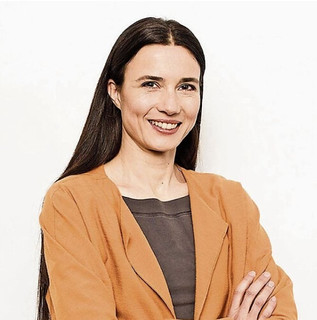 When the team at Noteworthy called to ask if I'd be interested in designing a bitcoin banknote, it was an easy
When the team at Noteworthy called to ask if I'd be interested in designing a bitcoin banknote, it was an easy Yes.
Their mission and vision to create a top-of-the-line physical representation of a digital currency is innovative, inspiring, and no easy feat. As Noteworthy's Chief Design Officer, I had the challenging task of developing a product that perfectly marries past and future, utility, and style.
Because of its complexity, Noteworthy had to ensure that each feature on the physical note was designed with intention and purpose. Designing a normal banknote is incredibly complex and there are many elements that need to be considered. But Noteworthy isn't a normal banknote, it's one that combines the originality of paper money with the security benefits of digital assets and blockchain technology, presenting the team with a whole set of new challenges. We had to scrutinize all elements of their functionality; which security features are important to users, what it should feel like, if we wanted to include a portrait, which color schemes would resonate with the public, and so much more.
We approached the design with the consideration that Noteworthy banknotes needed to have a familiar feel and look to a traditional banknote, but one that was able to function digitally. The front of the note has more simple elements that one may equate to the US Dollar or Euro, while the back contains more abstract concepts, highlighting the forward-thinking, modern nature of this project.
I have extensive experience in the analysis of banknote design, and Noteworthy co-founder Peter Vessenes was aware of my role in creating the ninth series of the Swiss Franc. He had incredible passion while explaining the project and his goal to create a banknote of the highest quality that would combine the trust, reliability, and security of paper currency with the modernity of digital assets. Peter's passion, along with the challenge that this project presented, immediately intrigued me and I promptly joined the team as its Chief Design Officer following this conversation.
Once I met with the team, I started drawing concepts and sharing ideas for what the design of something as unique as Noteworthy might look like. I would sketch these concepts by hand and then move the concept into a digital rendition on a computer. I would virtually show the designs to the team and we would collaborate on where we could enhance them even further.
The largest challenge was finding a way to see the design through on a physical substrate. I was tasked with not only finding a printer and style of printing that could combine the various drawings (which are layered) into one note, but one that could embed a cryptographic microprocessor as well. We also needed to ensure that the substrate physically felt like the banknotes we are accustomed to using in our daily lives. Luckily, I had formed several contacts in the printing and financial industries during my time with the Swiss Franc design, who I knew would be excited by this innovative project; we are fortunate to have a partner working with us to develop the type of notes we envision.
The various companies and team members I have met have been a pleasure to work with, as everyone is able to bring a unique skill set to the table. As the Noteworthy engraver, Thomas Hipschen has a unique eye for the smallest, detailed illustrations that are imperative to note functionality and bringing it to life. As Noteworthy's CEO Larry Felix has been able to ensure we see this project through to its fullest potential.
If we want to encourage more people to become involved in cryptocurrencies, we must create something that is trustworthy, secure, and unintimidating. Design processes have and always will be at the forefront of Noteworthy banknotes. It is incredibly important to our team that Noteworthy substrates look and feel of high value to encourage and exemplify trust in the financial world. I am thrilled to have been at the helm of designing and collaborating on this fascinating project that has the potential to shift the future of digital payments.
To read the complete article, see:
Meet the Designer Bringing Noteworthy Banknotes to Life
(https://www.noteworthy.ag/post/meet-the-designer-bringing-noteworthy-banknotes-to-life)
To read the earlier E-Sylum article, see:
BITCOIN BANKNOTES
(https://www.coinbooks.org/v24/esylum_v24n11a32.html)

